

If I Was The Man, Then I’d Be The Man: An Essay Inspired by Taylor Swift
An analytical-but-personal essay inspired by Taylor Swift’s song “The Man” and navigating a seemingly male-dominated music industry.
I n 2019, one of the most successful female artists of the century, Taylor Swift, released her seventh studio album Lover . However, it was only Swift’s first record she owned the full rights to. While it is true that Swift is not the only major artist to not own control of her entire catalog of masters — unless she rerecords each album , — she was notably receiving little-to-no support from her male musical peers.
It was only the other current female artists in the industry using their voices and standing up for her, Halsey and Lily Allen being just a few of the women rallying for Swift. Yet, when looking around at the discourse on the internet, predominantly on Twitter between white cisgender men, it’s these three chart-topping female artists (of many) that endure a slew of hatred online.
You might be asking, well, what do they all have in common? The answer lies in tracks with similar themes that present themselves, with descriptions of toxicity still present in all aspects of the music industry today. Whether it’s occurring or noticeable to your eyes, doesn’t mean it’s not happening. Allen’s “URL Badman” was released in 2014, yet still rings true. Allen, while she does namecheck Pitchfork, speaks about a concept that expands to the music journalism field as a whole.
As Guardian journalist Laura Snapes recently shared, “The music industry is so profoundly toxic and resistant to change, it feels unethical to participate in it at all sometimes.” When even independent record labels are engaging in a toxic Twitter discourse through now-deleted tweets, that’s when we should all be aware that something seriously needs to change.
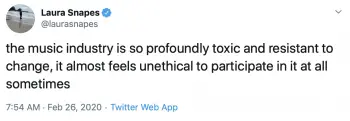
Speaking of Halsey, “929,” from her new album, includes the line, “ They said, ‘Don’t meet your heroes. They’re all fucking weirdos.’ God knows that they were right ,” which could arguably apply to a slew of bands in the #MeToo era being exposed for misconduct — some alleged, some confirmed. Nevertheless, accusations should be taken seriously, as the saying goes, “If a tree falls in the forest and no one is around to hear it, does it make a sound?” It still fell, even if you weren’t listening or don’t believe that it did.
As for Swift, she has been the recent example and arguably, the bluntest, at portraying this disparity in the music industry on her latest Lover single “The Man.”
Swift writes from the perspective of how her life would be incredibly different if she were a man in music.
I would be complex I would be cool They’d say I played the field before I found someone to commit to And that would be okay For me to do Every conquest I had made Would make me more of a boss to you I’d be a fearless leader I’d be an alpha type When everyone believes ya What’s that like?
Watch: “the man” – taylor swift.
She faces these double standards head-on in her self-directed music video for “The Man,” donning prosthetics to become the man. Swift, as an embodiment of male privilege in the video, manspreads on the subway, surrounds themselves with models on a yacht, and is literally high-fived after leaving a one night stand. The man, in his eyes, can do no wrong.
After all, she’s experienced these double standards firsthand. If you analyzed charting male songs about relationships to the backlash they received about writing them, it would be near to non-existent. However, if Swift, a woman in her 20s at the time of songs like “Dear John” and “Back To December,” dates a typical amount of men and writes songs, it becomes punchlines for award shows on national television.

They’d say I hustled, put in the work, They wouldn’t shake their heads and question how much of this I deserve What I was wearing, if I was rude, Could all be separated from my good ideas and power moves
Now slowly approaching my twentieth birthday, I have spent years working in various aspects of this industry since I was fifteen. Yes, it is true that there are a few good dudes out there that are focused on bettering the collective industry as a whole, compared to just the individual self. Notably, Ross Martin from the defunct UQ Music , Ariel Bitran, and Atwood Magazine ’s own Mitch Mosk.
However, there are other male peers I’ve encountered along the way, that as I’ve become more self-aware, I’ve become disillusioned by their inability to use their platforms to create change of any magnitude, especially if they have a large influence on social media. No matter what area of the music industry you work in, there is always room to grow and call for change, notably white cis males standing up and supporting those who are different than themselves.
Just last month, 98 KCQ, a Michigan-based country radio station, tweeted, “ We cannot play two females back to back. Not even Lady Antebellum or Little Big Town against another female .” This brought a larger conversation about women in the country music industry to the forefront, with heavy-hitters like Kacey Musgraves and Kelsea Ballerini joining in. This is best described in a brilliant and well-written article by Chris Willman about the situation. With a toxicity towards women in this musical subsection that’s been present long before the Dixie Chicks, it’s no wonder Swift made the switch to pop radio in an attempt to gain the respect she deserves.
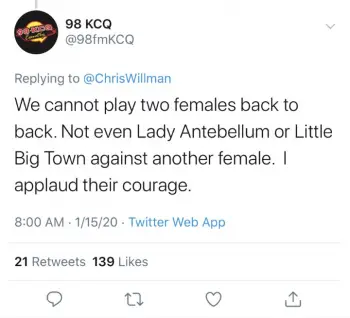
Even with country radio being a smaller part of a current and relevant conversation about a woman’s place in the music industry, the men I knew who worked and performed in this specific subsection never said a word about it — neither for or against. Nor did they say a word in November of last year, when Jennifer Nettles arrived at the Country Music Awards with a cape that read, “ Play our f—-in records, please and thank you .”
Instead, they used their social platform and place in the industry to heavily promote their own record (a collaborative duet between two men), and I found myself increasingly disappointed and losing respect in them.
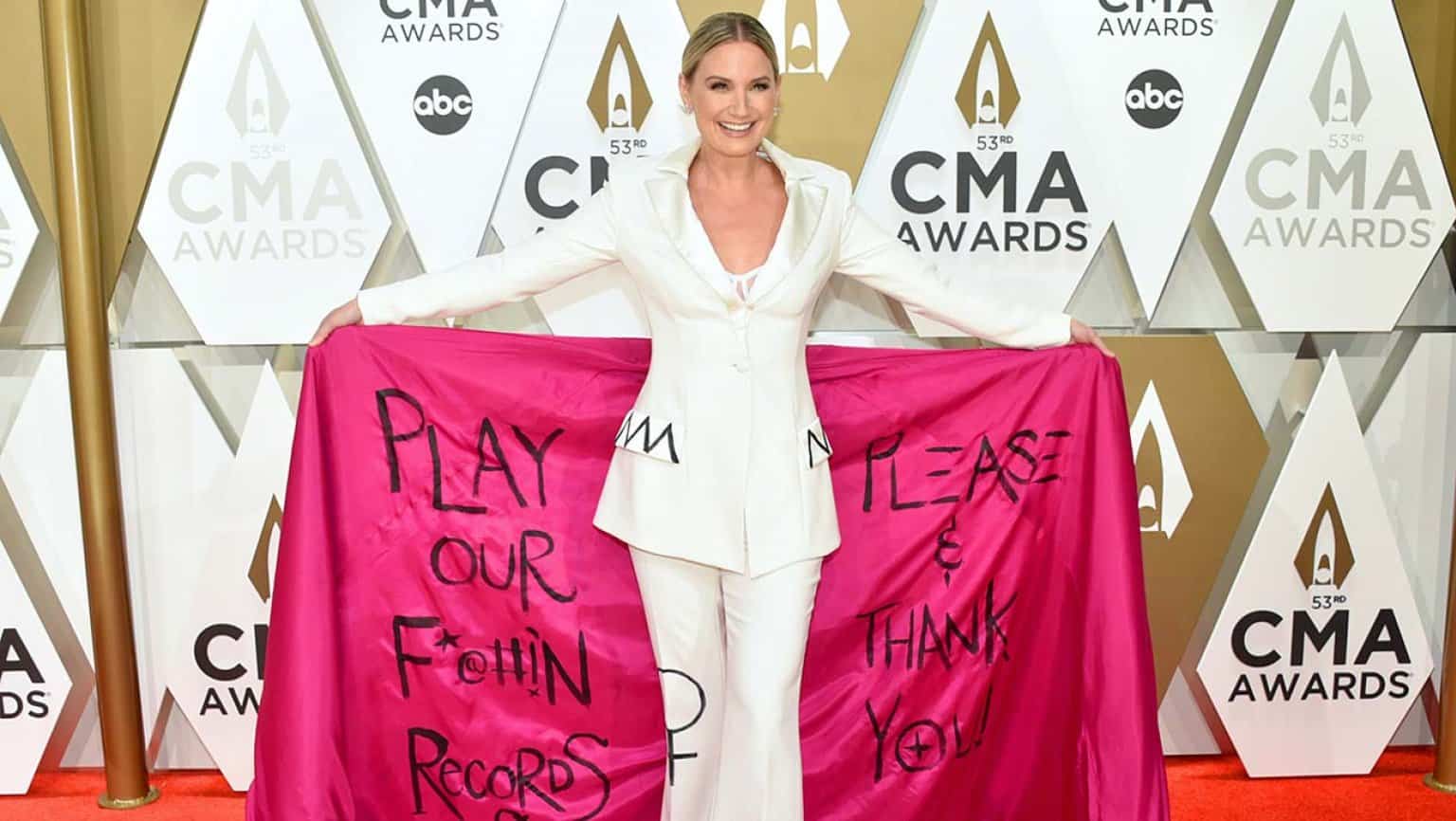
As Swift notes in her newly premiered Netflix documentary “Miss Americana,” she constantly was told regarding her place as, “A nice girl doesn’t force their opinions on people. A nice girl smiles and says thank you.” Yet, in an industry that as Swift describes as one that puts famous, yet successful, ladies in an “elephant graveyard by the time they’re 35,” when, in a career as a woman in music, do we cross the threshold of being “nice” and become someone worthy of respect?
I’ve urged other male writers I know to speak up about things that are happening, specifically the Reading and Leeds lineup debacle as one example. His response was one of, “Well, I support some women,” followed by a few paragraphs of mansplaining about money and indie publications, that I refused to open the can of worms into responding to before I could clearly articulate my thoughts.
If you are praising underground independent female artists, but tearing down chart-topping, mainstream ones, such as Swift, Halsey, and Allen from previous examples, in the same breath, that is not a pure and complete respect of women in the industry who went through consistent trials and tribulations to get to that success level. They tell us, “Respect your elders,” and in some exceptions, I do. Yet, at what point as a woman in music, do your elders start to respect you?

A few months ago, I attended a show for a New York-based band that I had been interested in working with and learning the business aspect of things. The members consisted of all men in their early twenties, older than myself, but not by much. Other attendees at the concert consisted of their manager and various attendees at the Bushwick venue that night. However, once their manager met a male music journalist from Kerrang! , he didn’t speak to me again.
The second red flag and reduction I felt from the group that helped me decide to officially cut ties, came from their lead singer, who texted me a few days after their show, inquiring if I could write a “pretty little article” for them. I suppose this is that article he wanted — not little, but hopefully he finds it pretty. As for the Kerrang! writer at this gig, I gave him my email when he asked. Needless to say, it’s been months of silence, so the disheartening feeling has subsided.
When it comes to the subsection of music journalism within the larger scheme of the industry, I am aware of the certain privileges I have operating the field as a white woman, however, it has still been a process filled with reductive experiences from men. While working as a booking intern at a New York concert venue, a drunk performer in a spin-off group, formed by a member of an iconic band, unaware of my internship status, inappropriately attempted to invite a clearly underage (X’s on each hand) girl to an “afterparty,” only to have his advances blatantly rejected.
If I was out flashing my dollars, I’d be a bitch, not a baller. They’d paint me out to be bad, So it’s okay that I’m mad
Swift’s lyricism within “the man” feels not only like a long time coming in terms of her personal experiences, but also a breath of fresh air..
It’s a spot-on description of how many women in this music industry — or any male-dominated industry, for that matter, feel. It’s a social commentary about double standards and working-hard-but-getting-nowhere, that makes it all the better option to become Lover ’s next single. It’s a song and a music video release that dig into something deeper than themselves. Not only does the song have an already universal relatability because of its themes, but as a single, “The Man” will hopefully, reach and inspire the young women in the next generation in the same way. It will also, hopefully, inspire at least some men in the music industry to make some serious changes within themselves. In the meantime, the rest of us ladies will keep on running as fast as we can…

Connect to Taylor Swift on Facebook , Twitter , Instagram
Discover new music on atwood magazine, roundtable discussion: a review of taylor swift’s ‘lover’, welcome to the new era of taylor swift, taylor swift’s “lover” is dramatic and dazzlingly romantic, “ the man “, a music video by taylor swift, an album by taylor swift.

Interview with Mae Muller: London’s Emerging Star Talks New Music & Creative Growth
You may also like.
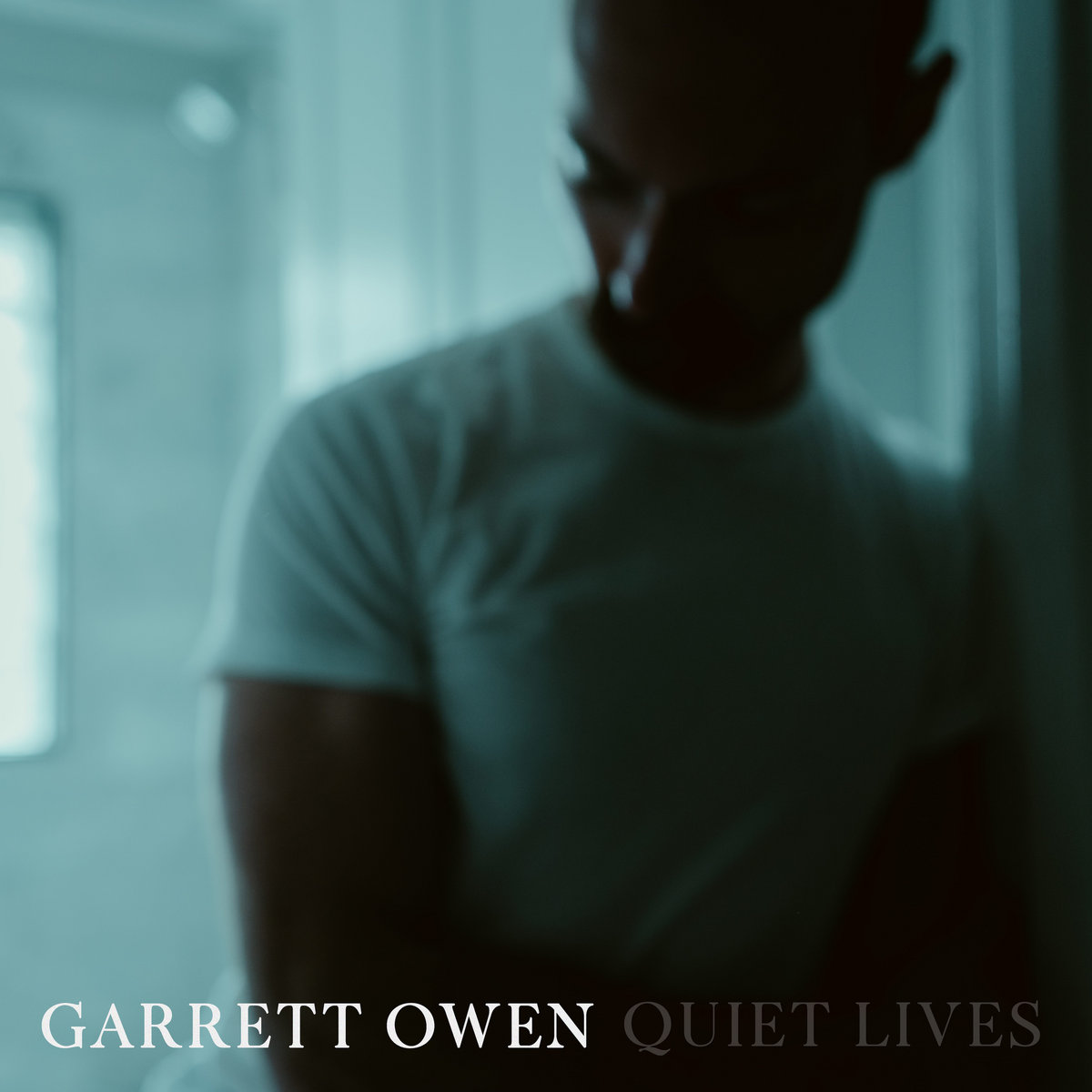
Track-by-Track: Singer/Songwriter Garrett Owen on His Stirring Sophomore Album ‘Quiet Lives’
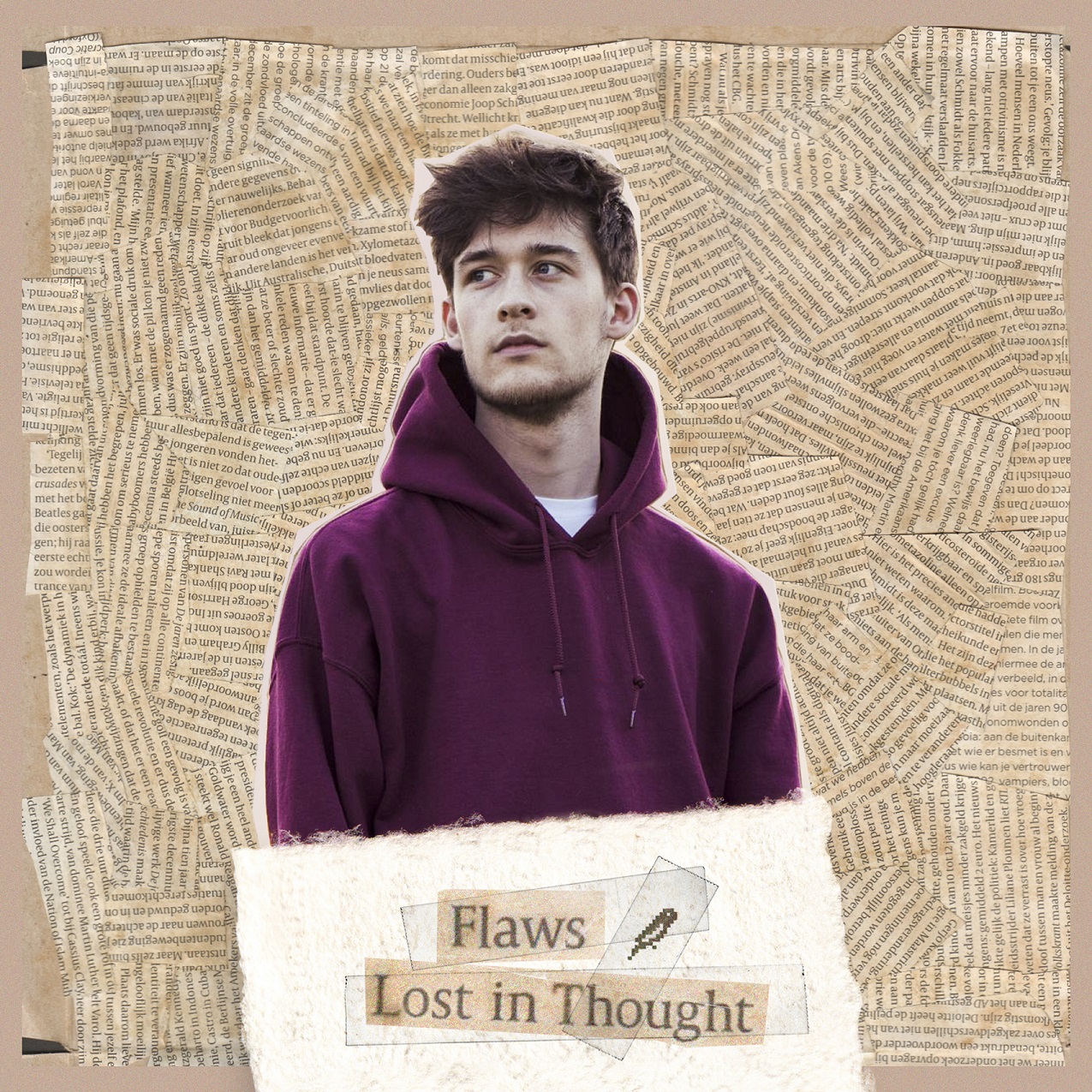
EP Premiere: Get ‘Lost in Thought’ with Flaws’ Dreamy Debut
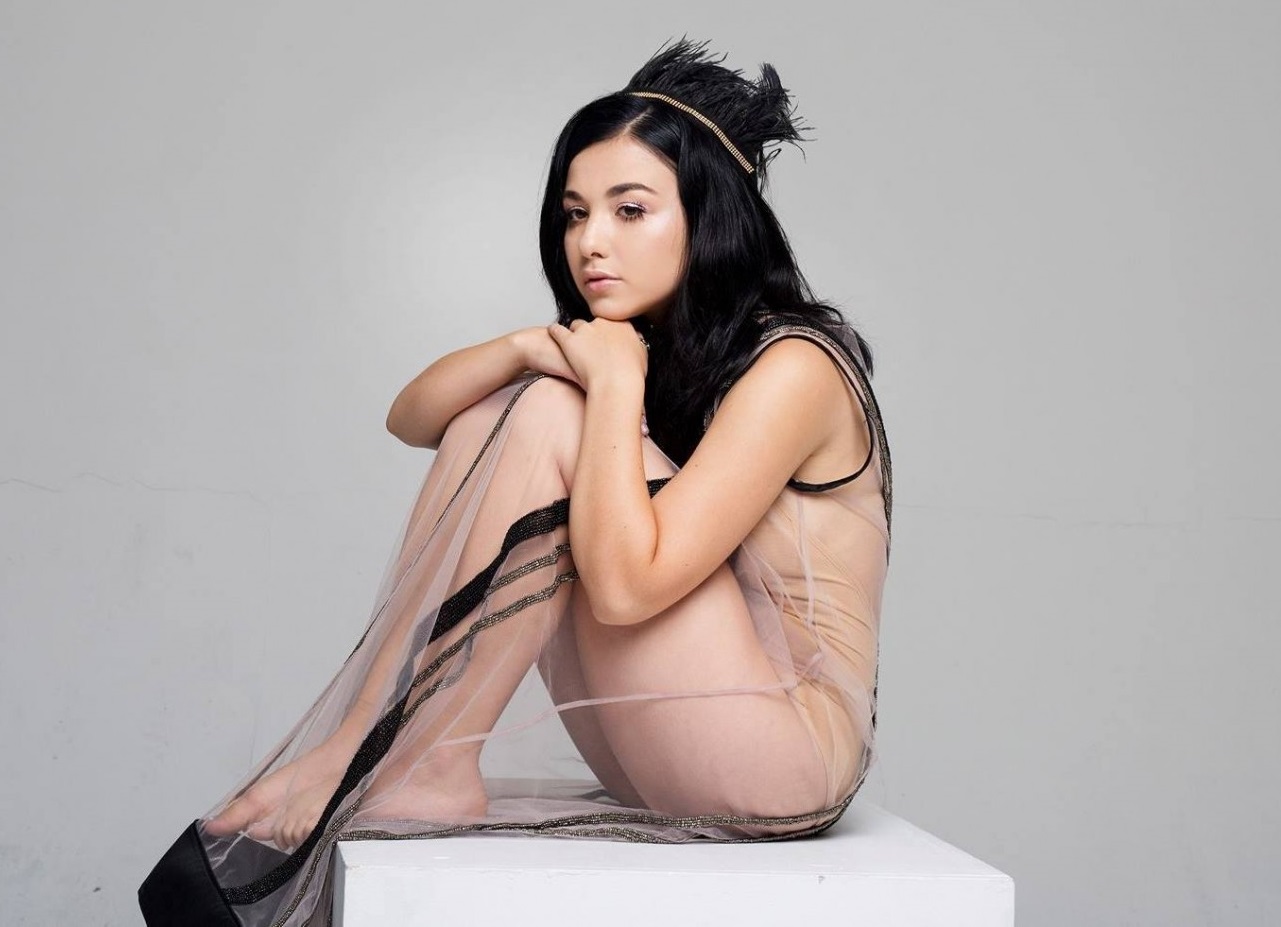
Embracing the Dark: A Conversation with EZI
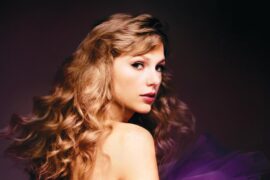
Nostalgia Tracks: Reconnecting With Taylor Swift’s ‘Speak Now,’ 13 Years Later

Our Take: INHEAVEN’s Timely Album is Just What a Debut Should Be

Premiere: Chicago’s Course Deliver a Synth-Soaked Inner Reckoning in “Too Busy for Feelings”
More stories.
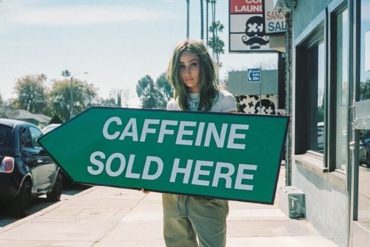
Today’s Song: phem Sheds Her Old Masks with Explosive New Single “slippery slope”

The Kablamo Quarterly
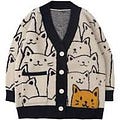
[Critique/Sequel] Taylor Swift's Cardigan: An Analysis of an Analysis of the Lyrics
Part ii: the recardiganing.

Hey everybody,
Thanks for once again attending my seminar on the Genius.com interpretation of the lyrics to Taylor Swift’s popular track, Cardigan , off the hit 2020 album Folklore.
When we last visited this subject, we discussed the first half of the initial verse of the song (three lines total) and the exhaustive and thoughtful annotations provided by Genius.com. So dense was the analytical content therein that we were only able to get through that much of the song in our last class. It would never be my intention to rush through subject matter without giving it proper consideration, but if we want to get through this whole song before the end of the semester, we’re going to have to pick up the pace a little bit here. So, with that in mind, today we’ll be going through the second half of the first verse and the refrain.
Now, I’ll admit that our last piece was pretty heavy on the caustic sarcasm surrounding the Genius.com annotations. In reality I don’t think there’s anything wrong at all with digging deep into something you love, and though I reserve the right to crack a few jokes just as I would defend to the death the right of anyone to crack jokes at my expense based on writing I put out into the world, I think that it’s awesome for people to think deeply and critically about art they consume.
That having been said, going through the next lines of the song, I feel like there is something, beyond dumb jokes, that we can learn about the art of criticism from the annotations therein, chiefly the importance of focus and emphasis. Let’s get down to business.
Here are the lines we’ll be looking at today in full. A grey highlight indicates lines that have a Genius.com annotation, which we’ll dive into subsequently: Sequin smile, black lipstick
Sensual politics
When you are young, they assume you know nothing *
But I knew you
Dancin' in your Levi's
Drunk under a streetlight, I
Hand under my sweatshirt
Baby, kiss it better, I
*Indicates this lyric has the same annotation as previously discussed in the last piece.
Right off the bat, the imagery in these lines is more richly realized than in the section we talked about last time, and the annotations do seem to reflect that, but now come along with me on a journey back and forth between some extreme variations in tone and significance of subject matter.
From Taylor: Sequin smile, black lipstick
From Genius: This description is strikingly similar to the outfit Swift wore to the 2016 Met Gala, where she allegedly met Joe Alwyn, her boyfriend as of folklore ’s release. It’s also worth noting the contrast between this lyric and Swift’s usual mentions to lipstick — on tracks like 2014’s “Style” and 2017’s “End Game,” she describes wearing red lipstick. She wore dark lipstick with sequin-like glitter in the music video for her 2016 track “I Don’t Wanna Live Forever” [photos removed]
From Me: These first annotations are clearly focused on the imagery from a fashion perspective. We’re getting some insight into how Taylor’s invocation of color here differs from previous iterations, showing a contrast to earlier lyrics. The note stops short of making any arguments about what this black vs red contrast might mean for the song, or what the significance is of potentially alluding to an outfit she wore with her boyfriend as of the album’s release on a song that’s clearly about a relationship gone wrong, but the focus is there. The focus is on fashion, color, aesthetics. Now let’s take a look at the next note.
From Taylor: Sensual politics
From Genius: Taylor had maintained a long-standing silence on political issues for the majority of her career. This changed in 2018 when she took a stand against a Republican candidate in her home state of Tennessee.
The idea of playing ‘sensual politics’ is two-fold for Taylor:
1) She shed her ‘American sweetheart’ image for an emboldened female in charge of her own sexuality as explored during her Reputation era (and referenced in the preceding lines);
2) She became something of a feminist talking point in the music industry regarding her assault court case against a radio DJ as well as her fight to own her own masters in an industry soaked in “toxic male privilege”. She also expressed similar sentiments about being a woman in the music industry in her 2019 single “The Man”.
“Sensual politics” is also a reference to Sexual Politics by Kate Millett. Published in 1970, the book became a landmark feminist work that pointed out the ways in which women are subjugated and exploited through art and popular culture.
From Me: And in just one line, the focus of these annotations has shifted completely from lipstick contrast to extremely weighty issues of social justice. From a reader’s perspective, it’s honestly difficult to imagine a greater case of whiplash than that. What fascinates me so much about this annotation is not only how it comes out of nowhere with points and context that are far more interesting to me than anything else that I’ve seen so far, but also how it seems to refer to notes that should have been teasing out these issues previously that have either been removed or changed at some point, because (spoiler for those who haven’t read the first piece) absolutely none of the previous annotations allude at all to issues of toxic masculinity or politics. One of the things that I’ve always found a little problematic about Taylor is her reticence to take a prominent stance on political issues and issues of toxic masculinity in the music industry, things that I 100% believe everyone working in and consuming the art of that industry has a responsibility to acknowledge and combat. Even if it does seem to be a lot of meat to dig out of two lines, this note is already infinitely more interesting to me than anything else I’ve seen on Genius.com so far. If there’s a solid point to be made here about how this song as a whole relates to and dissects Taylor’s experiences dealing with extremely important issues like this, that’s the critique that I want to read. With that in mind, let’s take a look at the very next unique annotation.
From Taylor: Dancin' in your Levi's
From Genius: Levi’s is a classic American denim company. This imagery is reminiscent of Swift’s country lyrics, such as her 2006 debut single, “Tim McGraw”:
Think of my head on your chest
And my old faded blue jeans
She also mentioned wearing them on August 2019’s “London Boy”:
I love Springsteen, faded blue jeans, Tennessee whiskey
As of this song’s release, Swift’s most recent mention of a lover wearing jeans was on November 2017’s “Delicate”:
Dark jeans and your Nikes, look at you
From Me: And there’s that whiplash again, just snapped right back out of it. Here Genius.com was starting to discuss some interesting and nuanced points about how Taylor Swift is perhaps dealing with some very important subject matter, and the very next note is just a description of three other times she mentions pants.
Let’s stop for a second. I want to make a few things clear:
I am not anti-pants. I am not anti-philosophical-discussions-about-pants. I think if you wanna compare the time she mentions pants here to other times she mentions pants, you should absolutely be able to do that, and cheers to you to boot.
I am not saying that every single line of a song has to serve a single idea or develop a single metaphor. I know that songs are often about multiple things. And, perhaps most importantly, I know that these Genius.com annotations are written at different times by different people who aren’t necessarily paying attention to what they all say. The writers of these Genius.com annotations are fans writing about what they love and find important in the song, and I bear them absolutely no ill will. I guess all I’m saying really, to Genius.com, is this honestly the best system here? Theoretically, I’m on your website looking for a more in-depth look into the music that I love. There are a thousand different reasons to love a song. Maybe I’m on here hoping to find out more about how this song relates to Taylor Swift’s overall thoughts and feelings about politics in the industry, or maybe I’m on here because I’m interested in the aesthetic evolution of fashion and how that plays out in her music. I feel like, no matter why I’m on here though, to have those two areas of focus presented so flatly just side by side, comparing favorably in length, just leaves me feeling more confused about what this song might actually be about. More importantly, however, it threatens to weaponize my feelings about the song and its interpretations, because eventually you’re always going to feel your focus is being attacked in some way.
Why did this strike a chord with me reading these lyrics? Maybe it’s because it reminds me of what too much of our discourse is beginning to sound like. With everyone eager to weigh in on everything and a flattening of the planes of communication that allows us all to broadcast at equal volume, it is extremely easy for focus and nuance to become lost in that din. I absolutely believe that we all should have a platform to express ourselves and speak out when we want to be heard, but the danger is that it can become too easy, and in some cases too attractive, to allow those flat planes of communication to train us to ignore focus and nuance. There are so many complex conversations that should be happening and that need to happen for us to move forward as a society, and right now the challenge of doing that seems so much more daunting compared with the allure of being able to, at any time, simply dismiss the matter with “well you’re focusing on the wrong thing,” or “you’re missing the point.” Once that happens, immediately you are on trial rather than your thoughts and opinions, and you’re also moving forward with the certainty that you’re not being listened to, and any potential for a meaningful exchange of ideas dies on the vine.
I’m not going to even go into depth with the last annotation we’re looking at today, for the line “Drunk under a streetlight, I” because it’s essentially the same as the jeans one, just mentioning other times in Taylor’s music she’s used the imagery of cars and street lights discussing a romantic affair. Again, I’m not saying that’s inherently a bad thing, but how am I supposed to move forward and glean anything from these annotations if I’m worried they’re just going to read like a spiteful old married couple changing the channels back and forth the whole time?
Should there be a visiting experience you can choose coming to Genius.com, where they aggregate similarly focused annotations and then only show you those, depending on a filter or hashtag system, so you know you’re getting a coherent review? Maybe. I’m honestly not sure. The only thing I am sure of is that the strange sense of frustration I feel combing through disjointed discourse like this makes me more and more conscious of that nagging tendency that I have to shut down, to refocus rather than engage, and to forgo nuance in favor of familiarity. I truly believe that if we were to examine how we communicate, not to reduce the amount of freedom people have to express but rather think more critically about how we present and focus that expression, we’d all feel a little more comfortable stepping outside of our echo chambers and learning something new, or even a new way to think about something familiar.
Well, that’s the next few lines of Cardigan down folks. For our next installment, I might dip back into sarcasm a little deeper, since in this piece I fell back on my classic technique of falling down a conceptual rabbit hole where the realization at the bottom is “maybe I should just try being less shitty all the time.” I hope that you came away from this with something, and hopefully something more pleasant. Till next time!
Ready for more?
Things you buy through our links may earn Vox Media a commission.
So, What the Hell Folk Tales Is Taylor Swift Telling Now on evermore ?
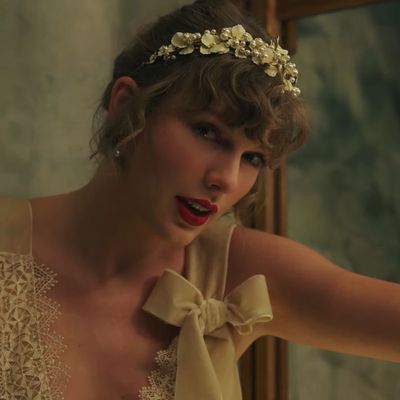
Every Taylor Swift song throughout history can be described as “music to braid your best friend’s hair to,” but with the surprise release of Swift’s ninth studio album evermore, finally, girls with long, creepy braids and sweet crushes on their best friends are getting the representation they deserve.
Swift announced on Instagram Thursday morning, like a shot of elderflower syrup to the heart, that she’d be following up the surprise July release of folklore with its surprise sister album, evermore , at midnight, December 11. Immediately, I returned from the haunted forest I’d been living in since July via horse and buggy seeking Wi-Fi. After a few listens, I must say, evermore absolutely fucks. If this is truly folklore’s sister, then it’s folklore’s more powerful, hulking sister. If folklore is Piper Halliwell — subtle, thoughtful, stressful — then evermore is Prue, in that her power is unmatched and she will kill you.
This album is so excellent that I’m suspicious: Did someone pry open a cursed locket and damn Taylor to an eternity of Albums of the Year? Either that or Taylor has Jack Antonoff and Aaron Dessner trapped in those pods from The Matrix, siphoning their woodsy power . If it’s actually the latter, nobody red-pill them — sad Swifties need this. evermore is woods-dyke excellence. Here’s my analysis of every song.
God, there are so many Easter eggs in the “willow” music video — this is exhausting. The video prominently features Taeok Lee, a dancer from her Red tour; there are numerous folklore callbacks, like Swift following a golden string toward her lover (“invisible string”); we see her wearing the titular folklore “cardigan;” a younger Taylor plays in a blanket fort (“seven”). But something that’s gone severely underlooked here is that this music video is very aesthetically similar to Lesbian Bonnet Films , which if you don’t know, is an emerging genre of depressing lesbian movies set before Penicillin existed. Between the witchcraft Taylor performs in the music video (she’s literally wearing a cloak — savagely gay) and the overall bonnet energy happening here, I think “willow” is actually a trailer for a new A24 lesbian movie that will inexplicably be written by a man.
“champagne problems”
As one of the three songs co-written by William Bowery — whom Taylor revealed to be her b*yfriend J*e A*wyn in the also-surprise folklore long pond sessions Netflix concert film — “champagne problems” is depressing as hell. The piano intro alone is enough to politely tap me over the edge. J*e also co-wrote “exile” and “betty” on folklore . As a person who deeply wishes Taylor were queer, admittedly, I’ve had trouble accepting J*e into my heart. But with lyrics like “November flush and your flannel cure,” and a tendency to romanticize the worst things that have ever happened to you, I do feel like J*e can relate to me. I’m not quite ready to spell his name without an asterisk, but these things take time. What was I talking about? Oh yeah, this song is about heartbreak or whatever.
“gold rush”
Yes, some fans have speculated that with lyrics like “everybody wants you” and “what must it be like to grow up that beautiful,” this song is about Harry Styles, who has a song called “ golden ,” and is also extremely beautiful. I might have bought that … if I didn’t know that “gold” is a trigger word in Kaylorlore which opens a Pandora’s box of references to Swift’s rumored romantic relationship with former best friend Karlie Kloss. Her reputation album features numerous Sapphic “gold” references: On “Dress” and “Dancing With Our Hands Tied,” songs about loving someone in secret, Swift sings “Made your mark on me — golden tattoo,” and “You painted me golden.” Kaylors (Taylor and Karlie truthers) believe “gold” lyrics point to the night Taylor and Karlie were photographed wearing matching gold flash tattoos. So, yeah, read a fucking book.
’tis the damn season
Like folkore, evermore features anthology stories written from characters’ perspectives rather than Swift’s POV. “’tis the damn season” is tied to “ dorothea ,” and is about the experience of coming home for the holidays and rekindling an old flame (more on Dorothea in a bit). Given lyrics like “you could call me babe for the weekend,” “I’m stayin’ at my parents’ house,” and “I escaped it too, remember how you watched me leave” — many people don’t know this — but this song is actually written from the perspective of Riley in Happiest Season . Played by Aubrey Plaza, Riley wasn’t hung up on her hometown old flame, Harper — but she definitely should have called Harper’s girlfriend Abby “babe” for the weekend. ’tis the GODDAMN season for THAT.
“tolerate it”
Okay, “ tolerate it ” made me unexpectedly burst into tears the first time I heard it. In a note to fans, Taylor wrote about an “‘unhappily ever after’ anthology of marriages gone bad,” about “infidelity, ambivalent toleration, and even murder.” A lover’s “ambivalent toleration” is the most harrowing to me, personally. No one has ever been as “ambivalently tolerated” as a queer girl who is way too nice to her best friend right before realizing she’s queer. Swift basically lobotomized me with the lyric, “I know my love should be celebrated, but you tolerate it.” Just bury me. Cover me in moss and dew and lay me next to a damp log to suffer through this album.
“no body, no crime” (ft. Haim)
Right after “tolerate it” comes Dark Marriage Anthology track two, the murderous “ no body, no crime ,” which features a long-awaited collaboration with Swift’s besties, Haim. In a YouTube chat, Swift revealed that “no body, no crime” was inspired by her love of true crime podcasts. The song follows a woman named Este (named for Este Haim) whose husband cheats on her. Swift told Entertainment Weekly , “Long story short, I’m the 4th Haim sister now, confirmed.” Can I just say: Writing fanfic about a Haim girl is extremely fucking queer. Writing yourself in as the fourth Haim sister? That’s gay, luv. This “Goodbye Earl” derivative work also reveals that one of Este’s sisters took out a life insurance policy on the cheating husband, who Taylor Swift then killed … Okay. Scheming? A cheating husband? Being in cahoots over a life insurance policy? I’m sorry, this song is about A Simple Favor — I will not be explaining.
“happiness”
Swift told her fans that “happiness” was the last song written on evermore, and was actually written last week in a Madewell. Okay that last part isn’t true, but as a white woman shaped like a rectangle, I can make Madewell jokes. “happiness” contains numerous references to The Great Gatsby, like “All I want from me now is the green light of forgiveness,” a possible allusion to the green light at the edge of Daisy’s dock, and “I hope she’ll be your beautiful fool.” In Gatsby, Daisy says her hope for her daughter is that she’ll be a fool: “That’s the best thing a girl can be in this world, a beautiful little fool.” Swift has alluded to Gatsby in the past, like her “roaring 20s” lyric in “the 1,” or “Feelin’ so Gatsby for that whole year” on “This Is Why We Can’t Have Nice Things.” This title is deceptive, as it’s actually quite heartbreaking, and is about literature, which feels somewhat exclusionary because gay people can’t read.
Much like the folklore track “ betty ,” “dorothea” is written from a male perspective. At this point, I’ve had enough time to grow and mature past believing that writing a love song about a girl but insisting it’s from the male perspective is quite gay. I’m actually not mad about it anymore and feel really good about this. In a note to her fans, Swift said Dorothea is “the girl who left her small town to chase down Hollywood dreams.” Tied to “‘tis the damn season,” this song is written from the perspective of the old flame from Dorothea’s hometown, a man who will no doubt teach his Big City Girl the importance of Christmas Cheer, which she likely traded in for a lifeless, spiritless, atheist existence in the Big City (which is freezing). Honestly, Dorothea needs to leave this Christian flop behind and go back to being a lifeless atheist. Christmas Cheer?? A hometown b*yfriend who is probably Republican??? In this Great Depression????
“coney island” (ft. The National)
Unfortunately this song features many men (although I do feel that in writing about it, I am queering this space): Aaron Dessner’s band The National, vocals from Matt Berninger , and a co-writing credit from William Bowery a.k.a. J*e — okay fine, I’m choosing to show growth here — Joe Alwyn. The song is a teary ode to a lover who passed away. It also features a reference to my favorite Taylor song ever, “ Delicate ,” a song about that fraught early-dating period when the relationship is still so fragile. She sings, “Did I close my fist around something delicate? Did I shatter you?” And then I shattered so quickly and so violently that I became gay sand.
Sagittarius Season is upon us, folx. Taylor, noted Sag, says she released evermore to celebrate her 31st birthday, which is December 13. As a Sag myself (my birthday is the day after Taylor’s, not to brag), I feel comfortable saying that the “ivy” lyric “I wish to know the fatal flaw that makes you long to be magnificently cursed” is the most Sagittarius lyric ever. The drama! The belief in extreme literary phenomena like “fatal flaws!” The use of the word “cursed!” Also, “ivy” is the third song in the Dark Marriage Trilogy, and Swift left “ivy” and “willow” Easter Eggs within her evermore announcement Easter Egg. Again, exhausting. I cannot read nor do math — just give it to me straight.
“cowboy like me”
This song is about “two young con artists who fall in love while hanging out at fancy resorts trying to score rich romantic beneficiaries,” according to Swift. “cowboy like me” features background vocals from Marcus Mumford, a guest feature that was alluded to in an Instagram from inside his studio. The song features the magnificent lyric, “Perched in the dark, telling all the rich folks anything they wanna hear like it could be love, I could be the way forward, only if they pay for it.” So, “cowboy like me” is about scamming rich people — something we can and should do.
“long story short”
Reportedly, this is the most autobiographical song on evermore . In Swiftlore, it’s well known that Taylor met Joe Alwyn during a lull in her life, on the same night she met Tom Hiddleston, whom she briefly dated, then dumped and got together with Joe. “long story short” is about picking the wrong guy, but in this song, she ends up with the right guy (Joe). So, some fans think it’s a Hiddleston allusion, a Hiddleusion. Swift also sings, “But we live in peace,” a reference to folklore song “peace,” which is also allegedly about Joe. This song prominently features the word “misery,” which may or may not be a reference to 1990 Kathy Bates psychological thriller Misery — the original “mad woman.” I’m joking (barely).
I love wholesome grandparent content . On folklore, the 13th track is about Swift’s grandfather. On evermore, track 13 eulogizes her grandmother Marjorie Finlay, who was an opera singer. Finlay’s background vocals are actually featured on the track, which, for the record, is the correct way to honor a late family member — not by Frankensteining together a spooky hologram , @ Taylor’s nemesis K*nye W*st!!
So, given that “closure” is about things ending terribly with someone (a friend, an ex, a malicious and megalomaniacal music manager ), the song could be about any number of public beefs Taylor Swift has had (K*m and K*nye, C*lvin H*rris, S*****r B***n). Honestly, I respect a woman who beefs. Remaining friends with an ex is a very popular phenomenon within the queer community — and it’s great most of the time — but there’s something to be said for a woman who knows her worth and is firm about it. “Yes, I got your letter, Yes, I’m doing better, I know that it’s over, I don’t need your closure” is my new morning affirmation. This whole album is Taylor just absolutely mad with power, swinging her strap around post-Grammy noms.
“evermore” (ft. Bon Iver)
“evermore” is co-written by William Bowery (Joe), who also plays the piano on the track. It’s nice that she lets him do things now. She’s like, “Oh, you want to be a musician? Ok not now, mommy’s busy. Go play with your li’l piano and make beep beep.” The title track has a very similar vibe to folklore’s “ exile ,” in that it also features Bon Iver and a William Bowery writing credit, but also in its stench of wintry death. “evermore” is brutal. It’s a pandemic depression anthem. The lyrics “Gray November, I’ve been down since July” and “Hey December, guess I’m feeling unmoored” resonate. It’s exactly how I’ve felt since folklore mowed down my mental health like a snowplow pushing a bunch of grey slush into a ditch. Taylor is sad-baiting here — profiting off a community of people who are sad — which is fine, because she’s clearly sad too, and as the ole saying goes, “ it’s nice to have a friend .”
- vulture homepage lede
- taylor swift
- vulture guides
- way too close reads
Most Viewed Stories
- Cinematrix No. 26: April 1, 2024
- What’s Next for 3 Body Problem ?
- The Best TV Shows of 2024 (So Far)
- Walking Dead: The Ones Who Live Finale Recap: Pride and Prejudice and Zombies
- 3 Body Problem ’s Imagination Problem
- Cassie’s Lawsuit Against Diddy, Explained
Editor’s Picks

Most Popular
What is your email.
This email will be used to sign into all New York sites. By submitting your email, you agree to our Terms and Privacy Policy and to receive email correspondence from us.
Sign In To Continue Reading
Create your free account.
Password must be at least 8 characters and contain:
- Lower case letters (a-z)
- Upper case letters (A-Z)
- Numbers (0-9)
- Special Characters (!@#$%^&*)
As part of your account, you’ll receive occasional updates and offers from New York , which you can opt out of anytime.
Taylor Swift’s “Clean” - lyrics analysis
Taylor Swift's "Clean" from the album "1989" is a symbolic representation of the aftermath of a relationship and the journey to self-discovery and healing. Drawing on vivid metaphors and imagery, Swift narrates a story of heartbreak and eventual catharsis that echoes familiar cultural and literary tropes, all the while speaking to a universal human experience.
The opening lines of "Clean" establish a theme of drought as a symbol for emotional barrenness, the parched aftermath of a once-flourishing relationship. Swift sings, "The drought was the very worst / When the flowers that we'd grown together died of thirst." This symbolizes not just the end of a relationship, but the wilting of shared dreams and aspirations, much like the death of the flowers they had nurtured together.
Swift also employs the metaphor of a "wine-stained dress" that she can't wear anymore, suggesting the lingering presence of a past relationship that is now unfit for her present self. The stained dress symbolizes a memory that, despite its indelibility, has become an unfit representation of her current identity, demonstrating the dichotomy of clinging to the past while yearning for change.
The most prominent metaphor, however, is the use of water and rain as symbols of renewal. In many cultures and literary traditions, water symbolizes rebirth and cleansing – from Christian baptisms to the Hindu ritual of dipping in the Ganges. Swift employs this trope in the chorus: "Rain came pouring down / When I was drowning, that's when I could finally breathe / And by morning, gone was any trace of you, I think I am finally clean." Here, the rainstorm and subsequent drowning are paradoxically the moments where Swift gains her breath back, symbolizing a cathartic moment of release and the washing away of remnants of her past relationship.
This relationship, while broadly applicable, is also rooted in the cultural trope of the 'lost love' that pervades popular music. Think of songs like Adele's "Someone Like You" or Robyn's "Dancing On My Own," where heartbreak is a crucible for self-discovery and growth.
Literature, too, abounds with examples of this narrative. Consider Emily Bronte's "Wuthering Heights," where Catherine's tortured love for Heathcliff ultimately leads to her demise, or Charles Dickens' "Great Expectations," where Pip's unrequited love for Estella serves as a catalyst for his personal growth. Like these stories, "Clean" follows a character's journey through the aftermath of a love lost and the subsequent personal evolution.
In summary, "Clean" uses symbolism and metaphor to describe the painful but cathartic process of moving on from a failed relationship. Drawing from cultural, literary, and personal experiences, the song reflects the profound emotional journey that many undergo in the wake of heartbreak, emphasizing the eventual attainment of self-renewal and liberation. It's a narrative of resilience and a testament to the human capacity to heal and grow from emotional hardship.

Who is Taylor Swift’s “Clean” about?
Who is “delicate” about.

Swift Lover
The Best Taylor Swift Fan Site
Taylor Swift’s ‘Cardigan’ From ‘Folklore’: Full Lyric Analysis
“Cardigan” is a captivating song by Taylor Swift from her eighth studio album, “Folklore,” which was released on July 24, 2020.
Written by: Allison White
Published on: May 26, 2023

Cardigan Explained
“Cardigan” is a captivating song by Taylor Swift from her eighth studio album, “Folklore,” which was released on July 24, 2020. The track showcases Swift’s songwriting depth and evolution, as she delves into the complexities of love, heartbreak, and personal growth. With introspective lyrics, haunting melodies, and atmospheric production, “Cardigan” immerses listeners into a world of nostalgia and vulnerability.
The song’s title, “Cardigan,” is a metaphorical representation of comfort, familiarity, and emotional resilience. A cardigan is often associated with warmth, protection, and a sense of being wrapped in something familiar, which becomes a recurring motif throughout the song. Swift draws a parallel between the comfort of a cardigan and the security found in a past romantic relationship.
One of the key themes in “Cardigan” is the concept of lost love and the wistfulness associated with it. The lyrics allude to a failed romance, specifically referencing a past relationship that Swift wishes to revisit, symbolized by the cardigan. In the first verse, she sings, “Vintage tee, brand new phone / High heels on cobblestones / When you are young, they assume you know nothing.” This opening verse suggests a mix of innocence and naivety, with Swift reflecting on a time when she was younger and perhaps more vulnerable. The reference to a vintage tee and high heels on cobblestones evokes a sense of nostalgia and a longing for a more carefree period.
Throughout the song, Taylor Swift interweaves vivid imagery and metaphorical language to tell a deeply personal story. In the chorus, she sings, “
Interested in learning more about Taylor Swift lyrics? View our analysis on other Taylor Swift song lyrics, like:
Taylor Swift’s ‘The Last Great American Dynasty’ From ‘Folklore’ Full Lyric Analysis , Taylor Swift’s ‘Exile’ From ‘Folklore’ Full Lyric Analysis , Taylor Swift’s ‘My Tears Ricochet’ From ‘Folklore’ Full Lyric Analysis
View all posts
Taylor Swift’s ‘Hey Stephen’ From ‘Fearless’: Full Lyric Analysis
Taylor swift’s ‘fifteen’ from ‘fearless’: full lyric analysis.
- United Kingdom
Is This What Inspired Taylor Swift's "The Man"?
Is this pivotal moment what prompted taylor swift to write "the man".
More from Music
R29 original series.
- Entertainment
- Let’s Discuss the Lyrics to Every Song on Taylor Swift’s <em>Lover</em>
Let’s Discuss the Lyrics to Every Song on Taylor Swift’s Lover
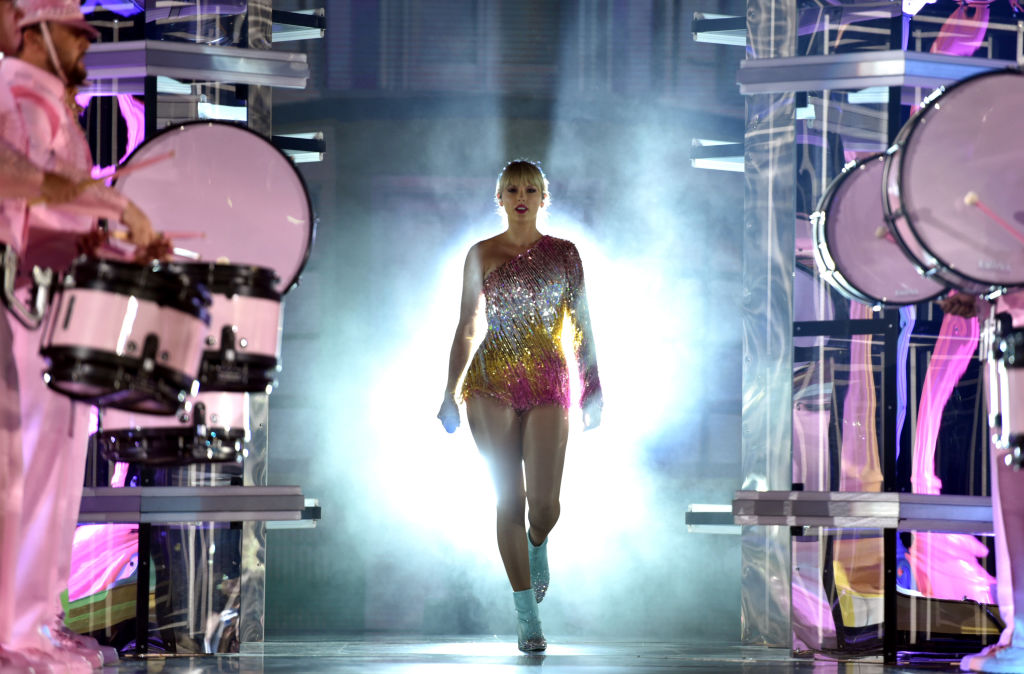
Lover , Taylor Swift’s seventh album , has arrived — as of midnight Aug. 23.
Featuring 18 tracks — Swift’s longest album to date — with singles “Me!”, “You Need to Calm Down” and “Lover,” it’s a pop tour de force that, as she has shared in promotional interviews, is her most romantic work yet — and potentially her personal favorite . “There are so many ways in which this album feels like a new beginning,” she told Vogue in a September cover profile. “This album is really a love letter to love, in all of its maddening, passionate, exciting, enchanting, horrific, tragic, wonderful glory.” Working with a heavy-hitter lineup of songwriters and producers, including Jack Antonoff and Joel Little, with assists from the likes of Annie Clark (better known as St. Vincent), Cautious Clay and Frank Dukes, Swift even features the Dixie Chicks.
Swift has long had a playful relationship with fan theories about her work and the messages she hides; she openly admits to lurking on Tumblr and has been known to engage with fans and their ideas online. For that reason, Swift scholars analyze every song and every lyric in an effort to open the window into Swift’s world just a little wider for the rest of us. As an artist, she’s sure to take liberties as she crafts her narratives and tells the stories she sees fit to share; fans and critics should be wary about drawing conclusions about her personal intentions. But the universe she has built over a decade-plus career is rich with its own legends. That’s why she’s consistently one of our most potent pop stars, after all.
With that in mind, here’s our breakdown of every Lover song, from the early singles “Me!,” “You Need to Calm Down” and “Lover” to the rest of the highly-anticipated project.
1. “I Forgot You Existed”
Bright, light and bubbly, “I Forgot You Existed” sounds like Swift’s final rejoinder to the darkness of the Reputation era. “I Forgot That You Existed” is an album opener with a purpose: to show she’s moved on, which she says in no uncertain terms. “I forgot that you existed and I thought that it would kill me, but it didn’t / And it was so nice, so peaceful and quiet… It isn’t love, it isn’t hate, it’s just indifference,” she shrugs, sing-talking her way through the tune, even throwing in a laugh.
2. “Cruel Summer”
Driving and synth-forward with co-production from Jack Antonoff and St. Vincent’s Annie Clark, “Cruel Summer” paints the picture of an emotional rollercoaster of a summer — new love and its uncertainties mashed up against the challenges facing pop stars in the public spotlight. “And I cried like a baby coming home from the bar, said, ‘I’m fine,’ but it wasn’t true / I don’t wanna keep secrets just to keep you,” she recalls, showing some of the rawness of her feelings in a way that calls to mind the vulnerability of Reputation ‘s “ Delicate .”
3. “Lover”
As the album’s title track, “Lover” shows off Swift at the intersection of sing-song acoustic pop and folksy storytelling. In turns intimate and chipper — and topped off with a faux wedding vow as the bridge — Swift harkens back to the sweetness of “New Year’s Day,” amped up with newfound bliss and confidence. “Swear to be overdramatic and true to my lover” is as good a moment of self-aware joy as anything a pop artist in the public eye could say. Still, she revels in the security of her relationship with a “magnetic force of a man.” (Swift fans have suggested that it’s an ode to Joe Alwyn, her boyfriend.)
4. “The Man”
Here’s an anthem for anyone who’s felt blocked by sexist double standards. Swift knows a thing or two about being treated differently in the music industry. As a woman in the public eye, she’s repeatedly stood up for herself against mistreatment by men, whether in the courtroom or through her music. In “The Man,” written with her frequent collaborator Joel Little, Swift reimagines that history in the form of a bombastic, empowering bop. “I’m so sick of running as fast as I can, wondering if I’d get there quicker if I was a man,” she complains. “Cause if I was a man, then I’d be the man.”
5. “The Archer”
Released as a promotional single, “The Archer” shows a more introspective side of Swift over a skittering synth line. Coproduced with Jack Antonoff, it has some of the more 80s sensibility that their previous work together (like “Getaway Car” and “Dress”) has also showed off. “I cut off my nose just to spite my face,” she sighs intimately. “I hate my reflection for years and years.” And while her lyrics are all fairly oblique, fans of Swift will surmise that when she says “I’ve been the archer, I’ve been the prey” she’s talking about how she has been cast in different lights at various times over her years in the pop culture discourse.
6. “I Think He Knows”
Over a snapping rhythm, Swift gets playful on “I Think He Knows.” “He got that boyish look that I like in a man,” she talk-sings with rapid precision: “He’s so obsessed with me, and boy, I understand.” There’s a refreshing self-awareness and sense of humor to this first-crush love song, which is laced with references to Nashville and descriptions of infatuation. But more than anything, Swift gets to play with her attitude, dropping in signature vocal quirks over the toe-tapping beat, backgrounded by a chorus of dramatic sighs.
7. “Miss Americana and the Heartbreak Prince”
Since breaking out in her teens as a rising country star, Swift has been consistently associated with the hallmarks of the American high school experience: homecomings and football teams, proms and cliques. But in “Miss Americana and the Heartbreak Prince,” she seems very ready to graduate from that scene. It’s one of her most layered songs on the album, and recalls the echoing, unhurried melodies of Halsey and Lana Del Rey as she mixes a love song with a subtle social critique: “American stories burning before me, I’m feeling helpless, the damsels are depressed, boys will be boys then, where are the wise men? / Darling, I’m scared.” It sounds like teen angst, sure, but maybe also something bigger.
8. “Paper Rings”
Then she kicks things up on “Paper Rings,” which is a toe-tapper from the get-go, filled with tambourine jingles and old-school background shouts. With the “uh-huhs” and the “that’s right’s” and the turned-up finishes to her line delivery, this is Swift’s let-down-your-hair song on Lover — a happy-go-lucky bit of rollicking fun. “Darling, you’re the one that I want,” she insists (which feels of a part with Grease and that famous Sandy-Danny duet), “and I hate accidents except when we went from friends to this.” “This,” of course, is happily paired up — a state she seems to relish.
9. “Cornelia Street”
Swift cut her teeth on storytelling, and that background shines on “Cornelia Street,” which alludes to a Manhattan neighborhood and the beginning of a love story. Her refrain — “I hope I never lose you, hope it never ends / I’d never walk Cornelia Street again” — packs a punch of relatability; some places just become too drenched in difficult memories to handle our traffic after heartbreak. “Cornelia Street” isn’t a ballad, but it is filled with bittersweetness over a lush synth base.
10. “Death by a Thousand Cuts”
“Death By a Thousand Cuts” is ostensibly a sad song, but it’s one of her prettier and more fast-paced Lover songs anyway, a sweet melody interspersed with a tinkling piano section that adds gravity to her melancholy lyrics. “You said it was a great love, one for the ages / But if the story’s over, why am I still writing pages?” she wonders at one point — and then documents the ways she tries to get over heartbreak (“I get drunk, but it’s not enough,” “Tryna find a part of me that you didn’t touch”) with resigned resilience.
11. “London Boy”
By the time “London Boy” rolls around, though, Swift is back to having fun. “They say home is where the heart is, but God, I love the English,” she insists as she name-checks spots around London and British traditions that she’s discovered for herself. It’s a happy-go-lucky bop with a minimal, looping melody that puts the focus on her lyrics as she calls out her “American smile” and the way she “fancies” someone new. It also features writing credits from Cautious Clay and Sounwave, collaborators that don’t pop up elsewhere on Lover — which might explain its distinctive flavor.
11. “Soon You’ll Get Better” feat. Dixie Chicks
A sweet country lullaby, “Soon You’ll Get Better” sees Swift teaming up with her longtime idols the Dixie Chicks for an acoustic ballad about illness and hoping for health. “In doctor’s office lighting, I didn’t tell you I was scared,” she recalls. “You like the nicer nurses, you make the best of a bad deal.” But ultimately the song is a kind of prayer: “Soon you’ll get better,” the phrase she keeps repeating, functions more as a plea than a proclamation, an uncertainty that the song’s delicacy echoes.
13. “False God”
“False God” sees Swift dabbling in more sultry territory, opening up with a subtle saxophone riff and then moving into a slow-burning R&B jam. “We’d still worship this love,” she repeats, getting breathier on every take even as she bemoans relationship challenges (“Hell is when I fight with you”). No need to worry, though: “You still do it for me, babe,” she says. This is Swift the true romantic, claiming that “heaven’s a thing” because “I go there when you touch me, honey.” It’s a shift from the tone — and sound — of much of Lover , but sees her slinking into what is perhaps her most sensual take yet.
14. “You Need to Calm Down”
Bright, bubbly and unabashedly vying for earworm status, “You Need to Calm Down” comes out swinging. It’s a colorful clapback (“Don’t step on our gowns!”) that works as a warning to homophobes, trolls and bullies, according to Swift. (“But snakes and stones never broke my bones” is as close a callback to Reputation ‘s darkest moments as we get in this album.) With a juicy, unhurried synth beat, it sees Swift sing-talking her way through a series of quotable lyrics. (“You need to take several seats” / “Shade never made anybody less gay”… and the list goes on.) With its cascading chorus echoes and simple construction, it’s Swift at her most pop-forward on Lover.
15. “Afterglow”
Swift returns to her songwriting team from “I Forgot You Existed” (Louis Bell and Frank Dukes) for “Afterglow,” which is a pretty straightforward apology power anthem, grounded by a slow bass and propelled by Swift’s unabashed contrition. “Hey, it’s all me, in my head, I’m the one who burned us down,” she explains, “but it’s not what I meant.” Luckily, she has a solution: “Meet me in the afterglow.”
16. “ME!” featuring Brendon Urie
“ME!” leans into a marching band drumline as its backbone, but the star is Swift’s celebratory confidence. Sugar-sweet and destined for school sing-a-longs (“Hey kids, spelling is fun!” must be a hit with the teachers), Swift veers away from her normally specific songwriting to instead offer up an anthem of self-love. “I’m the only one of me, baby that’s the fun of me” is about as universal as it gets. While it doesn’t hit the emotional notes of her most memorable work, it makes a strong statement.
17. “It’s Nice to Have a Friend”
With a children’s choir and a plinking piano to begin with, “It’s Nice to Have a Friend” feels like an about-face for Swift. It’s a story — of a childhood pair who end up as bride and groom — and there’s an unadorned innocence both to the ballad structure (with trumpets in the bridge, no less — a Beatles-y moment that perhaps takes a cue from her idol Paul McCartney ) and the content. “School bell rings, walk me home” turns into “church bells ring, carry me home” by the end of the song, condensing the arc of a relationship into just a few minutes of careful songcraft.
18. “Daylight”
With a slow build to a smooth, rich pop melody, “Daylight” echoes the dawn of a new consciousness for Swift. “I don’t want to look at anything else now that I saw you,” she sings, content: “I’ve been sleeping so long in a 20-year dark night, and now I see daylight.” Throughout Lover — and her other albums — color plays an important role in Swift’s lyrics; there are mentions of blue eyes, pink skies, neon walls, and here, golden daylight. She ends with a spoken outro: “I just think that… you are what you love.” It comes across as a benediction.
More Must-Reads From TIME
- Jane Fonda Champions Climate Action for Every Generation
- Biden’s Campaign Is In Trouble. Will the Turnaround Plan Work?
- Why We're Spending So Much Money Now
- The Financial Influencers Women Actually Want to Listen To
- Breaker Sunny Choi Is Heading to Paris
- Why TV Can’t Stop Making Silly Shows About Lady Journalists
- The Case for Wearing Shoes in the House
- Want Weekly Recs on What to Watch, Read, and More? Sign Up for Worth Your Time
Write to Raisa Bruner at [email protected]
You May Also Like

My best lessons are the ones that incorporate Miss Americana herself and using Taylor Swift as poetry means I have an excuse to play all her best songs. Besides speaking to my soul and defining my teens and twenties, Taylor Swift has amazing songs that are full of poetic elements that your students can analyze. Finding songs for poetry analysis is a great way to ease students into understanding how to analyze a poem. If you are frustrated with your students’ lackluster attempts at poetry analysis or you just want a reason to listen to Taylor Swift for the day, check out how I find ways to bring Taylor Swift into my poetry unit.
If you want to bring a little Taylor Swift into your lessons and don’t want to have to start from scratch check out my TSWIFT Poetry Graphic Organizers . Besides having Taylor Swift on every handout, students will learn how to analyze poetic elements and find cited examples. With both print and digital options, students will also examine the author’s purpose for the poem and how those elements help contribute to that purpose and can be customized to the poem(s) of your choice. If you want to see how I use these awesome handouts with Taylor Swift in all her glory, check out my lesson ideas below.

The Struggle with Poetry Analysis
Why my students just weren’t getting how to write poetry analysis.
When I first started teaching poetry analysis, I was incorporating the SWIFT poetry analysis method with my students. We would jump right into some of the great poems. I would teach them how to identify the speaker and the situation which was not necessarily a struggle. Thinking my students understand the basics, I had them search for all the poetic elements I could think of.
And just like that, the walls started to crumble. Students would struggle with a method to find all these elements. They weren’t sure how to take those elements and tie them together in a theme. They would start to get overwhelmed thus solidifying my students’ beliefs that poetry is hard and not for them. The struggle was real and my students and my lessons needed a change.
How Analyzing Taylor Swift Songs Changed My Poetry Unit
My inspiration for a change started with trying to find a relatable way to teach poetry. My students are obsessed with music so that seemed like the obvious choice. At first, I allowed my students to choose their own music but ended up down the rabbit hole just trying to find the “perfect” song.
That’s when I switched to choosing the songs for my students. I wanted to find clean songs full of figurative language, imagery, and themes. That’s where my love for Taylor Swift and her music came to the rescue. Every song is a Taylor Swift poem that highlights all of the main elements in the standard swift analysis. Besides my students recognizing most of the songs and lyrics, they finally started understanding how to analyze a poem. With a little off-key singing from me and major poetic creativity from Tay Tay, my class starts to get excited about poems!
Taylor Swift Song Analysis
Activity #1: analyzing taylor swift poem lyrics together.
On the opening day of my poetry unit, we start off with a discussion of what makes a poem and how it differs from a novel or short story. Once we establish such characteristics as stanzas, lines, and shorter writing pieces, I bring up the discussion of songs and how they are written in the poetic form.
In order to prove my point, we listen to Taylor Swift’s “All Too Well”. I recommend using the official lyric video and providing a copy of the lyrics so students can both listen to and read the words while the song plays. Once the song finishes, we start with identifying the speaker and situation. We have a conversation about how the speaker is not the author/singer so Taylor Swift cannot be the answer. We focus on the speaker as someone who has recently gone through a breakup and can’t let go of the past or stop remembering the relationship.
Once we understand the content of the song, we talk about how songs are organized with verses and choruses which are stanzas in poetic terms. We think about how the music and instrumentals set the tone for the piece. I have them search for imagery and figurative language that they remember from their younger years. Finally, we create a theme statement and discuss which words and lines best show the theme. This whole class discussion is setting them up for our next activity.

Activity #2: Taylor Swift Literary Analysis
The second way that I incorporate Taylor Swift in our first day of poetry is a Taylor Swift Song Choice Board. I create a choice board on Google Slides that have each of Taylor’s nine albums. *Note: For next semester, I am going to revise my board because Taylor Swift just released her newest album Midnights which you can check out HERE.
Here is my list of Taylor Swift songs that I use:
- Taylor Swift: Picture to Burn
- Fearless: Love Story
- Speak Now: Mine
- Red: I Knew You Were Trouble
- 1989: Out of the Woods
- Reputation: Getaway Car
- Lover: Miss Americana
- Folklore: Exile
- Evermore: Willow
Students are to choose a song from the choice board and listen to it. Once, they finish I have them complete a TWSIFT Poetry Cheat Sheet. This acronym poetry analysis worksheet organizes students’ thoughts by having them think about Tone, Structure, Word Choice, Imagery, Figurative Language, and Theme. As they listen, students will pull lyrics from the song to find examples for each part of the TSWIFT Poetry Cheat Sheet and then explain their answers in complete sentences. Students have the chance to learn how to properly cite poetry, identify poetic elements in a song, and analyze their song. If you want to check out my TSWIFT Poetry Cheat Sheet, click HERE .

T SWIFT Poetry Analysis Graphic Organizers
While not analyzing her music, another way that I bring Taylor Swift as poetry into my classroom is by using her name as an acronym to analyze poems. I created the TSWIFT Method adapted from the SWIFT poem analysis method. I even created Taylor Swift themed graphic organizers to go with the lessons. If you want to check them out, you can click HERE .
T is for Tone
Students never seem to understand the difference between Tone and Mood so I dedicate an entire day in my poetry unit to understanding tone and mood. Songs are a great way to show how different instrumentals set the tone. Using Taylor Swift as an example, I ask students to define the tone of each of Taylor’s albums. My students like to joke that she only writes about love and breakups so I challenge them to think about the different tones of each album. Sometimes she is romantic (SPEAK album) or independent (Reputation album) even her paired albums Folklore and Evermore have different tones.
For a poem example, we read two poems about the same topic but in different tones. I like using “Allowables” by Nikki Giovanni and “Mercy” by Rudy Francisco. They both discuss spiders but have two distinct tones. Students identify the mood and the tone with cited examples. Students then move on to analysis by considering how the tone contributes to the author’s purpose.
S is for Structure
For the next few days, we focus on structure. This concept is the foundation of most poetry analyses and the most diverse. There are so many types of structures that it is hard to teach them all. Instead, I focus on a few critical types. First, to show a traditional poem with a simple structure, we read “do not go gentle in that good night” by Dylan Thomas. Students use the Structure handout to evaluate rhyme schemes and stanzas. Finally, they determine how the structure contributes to the theme.
Once the students have the chance to see what structure should look like, I mess it all up with the poem “How to Write a Poem in Time of War” by Joy Harpo. This poem is perfect to teach students how structure can go all haywire to prove the author’s theme. We also dive into sonnets, haikus, free verse, and organic poetry.

W is for Word Choice
Once my students feel confident with structure, we move on to our W in the TSWIFT analysis. In the word choice graphic organizer, students look at impactful words and phrases that stand out to the reader. Students will find cited examples of impactful phrases. Finally, students analyze how the words lead to the author’s purpose. I use the poem “Plants” by Olive Senior because the poem focuses on how plants are at war with humanity. All the words are strong, aggressive, and warlike which shows how the author’s choice help to invoke the theme.
I is for Imagery
Perhaps the easiest letter in the TSWIFT acronym is imagery. Students have been learning about imagery for years (hopefully) and should be able to see the five senses in a poem. The imagery graphic organizer asks students to dig deep into the poem’s senses. Students will draw an image and analyze some of the most powerful images in the poem. Students will work towards discovering the theme and how the images contribute to the author’s purpose. I recommend using “Ogun” by E.K. Braithwaite. His poem focuses on a carpenter whose sorrow is shown throughout his work. There are vivid images and every sense can be found within the poem.
F for Figurative Language
When diving into figurative language, the most important part is making sure the students know the proper vocabulary. Here are the terms that I use with my students:
- Alliteration
- Personification
We normally play some review games to make sure students understand these vocab words before diving into a poem. Students are going to find multiple examples of different types of figurative language first. They will give cited examples and explain what type of figurative language it is. Students will then pick out the most important figurative language and discuss its impact on the poem. Finally, they will analyze how figurative language contributes to the theme. I recommend using either “Mother to Son” by Langston Hughes or “If” by Rudyard Kipling. Both poets have extensive examples of figurative language to analyze.
T is for Theme
Saving the best for last is the theme. As I tell my students, the theme is the most important thing that they will learn in my class. The theme is the foundation for everything they will read and analyze. I love using “So Much Happiness” by Naomi Shihab Nye. Students first think about the focus of the poem to better help them create a theme statement. Once they have created their theme, they will find cited examples and analyze how they contribute to their author’s life lesson.
While not directly using Taylor Swift songs, the TSWIFT method allows us to talk about my favorite singer throughout the entire poetry unit. And, any chance that I can have Taylor Swift in my curriculum, I am going to take it.

Other Ways to Teach Poems
T SWIFT Poetry Analysis
4 Ways to Teach Poetry Analysis for High School
3 Quick Poetry Activities for High School
If you are looking for a new way to ease into poetry or just love Taylor Swift as much as I do, try these ways to incorporate the Queen of Pop into your lessons. If you bring Tay Tay into your lessons or you find a new way to engage your students in poetry, I would love to hear from you. My poetry unit is always changing and I could use your insights!
Ready to add Taylor Swift to your curriculum? Check out my TSWIFT Graphic Organizers that you can use for any poem in your unit. By using the T. S.W.I.F.T. acronym, students will analyze the Tone, Structure, Word Choice, Imagery, Figurative Language, and Theme of any poem. Students have the option to use the T. S.W.I.F.T. Cheat Sheet where they look at all parts of a poem or use the individual poem graphic organizers for each element for an in-depth look at the poetic elements. Plus, each graphic organizer includes an image of Taylor Swift. I hope you find some great ways to teach Taylor Swift as poetry.

Download Your FREE Literary Analysis Essay Writing Teacher Toolkit Today!
Ready to take your literary analysis writer’s workshop to the next level?
Teaching how to write a literary analysis essay can be tough. If you want to simplify the writing process for your students while making sure you don’t forget any steps, then this toolkit is made for you!
Click HERE to learn more!
Privacy Overview
Midnights : An Analysis by Four Editors and Taylor Swift Fans
“It’s like 1989 , Reputation , and Folklore had a child all together.”

To help make sense of it all, we partnered with our friends at Cosmopolitan and gathered four Taylor Swift-loving editors to break down the new album in detail: Madison Feller, ELLE.com Senior Writer/Editor; Samuel Maude, ELLE Assistant to the Editor-in-Chief; Emma Baty, Cosmopolitan Entertainment Editor; and Tamara Fuentes, Cosmopolitan Associate Entertainment Editor.
Below, they talk through Midnights ’ best tracks and hidden messages, as well as Swift’s growth as an artist and how she subverts the public’s perception of her, all with a refreshing sense of humor. Listen to the full conversation here.
First Impressions
Emma Baty: I really enjoyed the album. I think it’s a really nice continuation of what she did with Folklore and Evermore , and kind of blends a lot of what we love her for, what she’s done in the past. I get flashes of every one of her albums up until this point.
Tamara Fuentes: It does feel like it’s a little bit [reminiscent] of past iterations, which I think is part of the point. She did note that she wrote this throughout different 13 nights throughout her career. And so we’re seeing glimpses of those moments. For me in particular, it feels a little too repetitive from things that we’ve seen before. Maybe I also had certain expectations like other listeners, where it might be more of a grungy indie vibe. It’s not my favorite album, I’ll definitely say that, but I think I had just different expectations and so I’m still kind of figuring that out as a listener.
Sam Maude: I love it, actually. I really enjoyed it. I agree with the fact that it feels a little repetitive in some places. I was taking notes as I was listening last night. The amount of times I was like, “Oh, this song reminds me of this other song in Taylor’s Swift discography,” or “This song reminds me of this Jack Antonoff song” was quite a lot. And I will say, this is such a Jack album to me, and by album I’m talking about the first 13 tracks we got, not the other seven that were released at 3 A.M. But it’s very Jack Antonoff’s style of a Taylor Swift song. I think this album shows how—in my opinion—wonderful the collaboration between the two of them is. I think it takes the best of Jack Antonoff and the best of Taylor Swift and really melds it together into this fabulous Taylor Swift album that I’m really kind of obsessed with. But I do think it can get repetitive to other Taylor Swift songs in the past.
Feller: Sam and I are on the same page. I’m obsessed. From first listen, I was like, “Oh, I think this could potentially be one of my favorite albums.” To me it’s like 1989 , Reputation , and Folklore had a child all together. I feel like I’m still parsing through. I should tell everybody that I am reporting from Spain. This came out at 6 A.M. my time, so I’ve been listening for almost 12 hours straight. But I haven’t dived as deep into the extra seven. But of the core 13, to me this is potentially a no-skips album, which is maybe controversial.
The Surprise Extra Songs
Baty: Who am I to question Taylor Swift’s release strategies? But I almost do wish she had let the album breathe as its own entity before releasing the extra seven songs. Because I woke up this morning and went straight to the album and was kind of parsing through that, figuring out how I felt about it. I wanted to listen to it multiple times front to back, and then I was like, “Oh my gosh, I have these seven other songs I need to also get through.” I wish she had kind of spaced it out a little bit more. I don’t know how you guys feel about that.
Fuentes: I completely agree. I think I wanted to kind of see how it is on its own a little bit before jumping into the bonus tracks. Though I will say this: I think the “3 A.M.” version kind of changed my opinion of it with some of the tracks. So maybe it was just a different way to try to get some listeners who were a little hesitant to see what else she was working with. But I’ve never seen somebody do something like this, so it’s definitely very interesting.
Maude: Yeah, I think this “3 A.M.” moment felt a little too soon. I wanted to sit a little more in it. And it also is a little weird to me that Aaron Dessner [who collaborated with Swift on Folklore and Evermore ] was relegated to these seven tracks and wasn’t on the 13 at all. I like the seven extra tracks, but again, I haven’t spent as much time with them and I agree with what everyone’s said there.
Favorite Tracks
Baty: If I’m looking at the track list, in order the first three songs, “Lavender Haze,” “Maroon,” and “Anti-Hero” really work for me. And then I feel like I get a portion of the album that I’m a little bit more neutral on. And then when I get back down into “Labyrinth,” “Karma,” and closing out with “Mastermind,” that really also works for me. I think it’s weird how my favorite songs are grouped at the top and the bottom of the album.
Fuentes: For me, I would say my top three are “Lavender Haze,” “Snow on the Beach,” and "Karma,” which are in some ways very vastly different from each other, which is kind of interesting.
Maude: I am definitely a fan of “Karma.” I actually love this track 5, “You’re on Your Own, Kid” and it’s been a bit on repeat for me this morning. And then I think “Anti-Hero” is a great first music video. I don’t know if it’s being branded as the lead single, but I think it’s a great choice.
Feller: I also love “You’re on Your Own, Kid.” My first listen through, “Mastermind” was my standout. That’s what I put on repeat immediately after I listened straight through. And I will say that “Sweet Nothing” really did something to me. I don’t think I really caught everything when I listened through the first time, but when I went back, I feel like it captures a very specific feeling that I relate to extremely hard, even though she’s kind of talking about it from her perspective of being a celebrity, which that part I can’t relate to. But even still, I think she really communicates a feeling in a very effective way that I’ve never really heard before. And I’ll admit that one made me cry. So I feel like that has to be in my top three. But in terms of the other seven, I feel like “The Great War” and “Paris” are very fun. And then I really need to dive lyrically into “Would’ve, Could’ve, Should’ve,” which, I don’t know if we want to speculate, but we think it is about John Mayer, right?
Fuentes: That seems to be the general take. Yes.
Feller: Are there any other standouts from the seven for y’all?
Fuentes: “Would’ve, Could’ve, Should’ve” was a really big standout for me. I actually liked the seven more, I think, than most of the original 13. Like “Bigger Than the Whole Sky,” “High infidelity,” [and] “Dear Reader.” I just really loved those tracks and, you know what? I’m kind of glad she took it out a little bit earlier just so I can get to experience them as well.
Maude: I’m on the “Great War” and “Paris” train for the last seven. But I will also say “Glitch” is an interesting song to me, and only because the Spotify background is the glitch of “Wildest Dreams.” Like that weird glitch people were speculating about and had this Easter egg, she put it as the background to “Glitch” on Spotify. This was such an “oh my goodness” moment.
Easter Eggs
Feller: I feel like on that note, we should talk about some of the Easter eggs, which, LOL that she put one in her NYU speech. That is so funny to me. And she put one in her first “Midnights Mayhem” TikTok, right? She did the “it’s me, hi.” Are there any other big ones that you feel like you’ve spotted or seen people talk about?
Baty: I don’t know if I would classify this as an Easter egg, but somebody pointed this out on Twitter, so I cannot claim this. But I love that when she used to write all these songs about the previous men she had dated, and there were obviously all these people who were being snarky and being like, “Well she should write a song called ‘I’m The Problem’” or whatever. And she basically subverted that for “Anti-Hero,” and I just love that she does stuff like that and she just messes with people. I don’t know if I would classify that as an Easter egg, but it’s a subtle or not-so-subtle clap back of sorts. And I really, thoroughly enjoyed it.
Maude: I mean that teaser trailer for all the visuals was just flooded with Easter eggs in my opinion. Like her being in the Reputation stadium tour outfit, her being in other outfits from her career, and that was like an “oh my gosh, what is going to be happening throughout this era of Taylor?” To me, in some ways, this album feels like a service to her fans, really capitalizing on the Easter eggs she’s had for so long and really just kind of leaning into her lore and her career. I think it’s really an interesting album in terms of how much her fans are—myself included—obsessing over it and going nuts.
Fuentes: I agree it’s very much a retrospective album. It just astounded me how quickly the fans were able to pick everything up. And I think that’s just a true testament to how much Taylor means a lot to them and also just how much fun she has with them and they play along as well.
Baty: I think she sees her fans as like collaborators in a way that other artists definitely don’t.
The “Anti-Hero” Music Video
Baty: I thought it was fun. I liked it. I would like to see more videos and also videos that work as a cohesive creative vision. I’m not saying they need to really directly play off one another, but I’m interested to see if she’s gonna go really hard with music videos for this album, and after hearing her speak about wanting to work even more in the visual medium of her work, I’m excited to see what she comes up with and the big picture of it all.
Maude: I saw reports that this was a visual album, which I don’t think has been confirmed, but I would love . I really loved the music video. I thought it was fun. I thought it was actually interesting commentary. I thought it was relatable in a lot of ways. Also, why did she make her children actively horrible in that music video? I thought that was funny. It was giving very Knives Out in that sense, kind of like “you’re not getting the money,” and I really enjoyed it.
Swift’s Self-Reflection
Feller: I also thought [the “Anti-Hero” video] was really fun and funny. I actually think the album as a whole is fairly funny, and I kind of love that about Taylor in her thirties. I just feel like she’s much more open to make fun of herself and be self-referential, but also own the things about herself than maybe she wouldn’t have talked about before. Like in “Mastermind,” where she says that she’s confessing about how much she really does create and plan and that that is rooted in these deep insecurities for her. But then parts of the song are also funny. I just feel like, as she’s gotten older, she’s done a really great job of being able to talk about the things that all the fans talk about and the media talks about in a way...she’s not putting herself down, but she’s still copping to things that we kind of all know be true about her.
Baty: I think it’s a way for her to reclaim those narratives about herself. To me it feels very, very like, “Oh, I know what everybody says about me, and guess what? In some ways you’re not wrong and I’m just gonna own up to it and, like, this is who I am.” And I do feel that with this album as well. It seems like her really looking at what the conversation is or what her public persona is and commenting very intentionally on that. And I think it really works.
Fuentes: I think “Dear Reader” stood out to me a little bit more maybe because it’s more emotional. But it also kind of reminded me a lot of Paramore’s “Idle Worship,” where the idea of how we kind of put artists on pedestals, where we look to them to help us and with these types of needs, but they’re also still very much human. Her speaking about that, I think, is one of the most honest moments we’ve seen from Taylor in a very long time, which I’m very happy to see.
The Lana Del Rey Collab, “Snow on the Beach”
Feller: I feel like I’ve seen a lot on Twitter that people are upset that [Lana] didn’t get a verse, which obviously I also would’ve wanted her to have a verse, but when she came in on the chorus, I audibly gasped and I’m kind of obsessed with how it sounds. But were you all disappointed that there wasn’t more?
Baty: Yeah, I am a little bit disappointed. I like the song, I just wish Lana had a little bit more to do so it felt more like a true collaboration between the two of them. Kind of like when Haim did a feature with Taylor Swift, that felt a lot more like two parties coming together to create something cool, that felt a little bit more 50/50. That being said, I still like the song but I wish it had a little bit more of Lana’s essence in it.
Fuentes: I think part of it has to do with the fact that, you know, you have a certain expectation when you see “featuring” on a track name, right? And so you kind of expect more of, maybe they’ll have their own verse or something or really work on vocals together and they also have their own shining moment. But that’s more of a conversation in terms of how royalties work and different things in the streaming age, but I will say I’m not entirely too disappointed. We do hear Lana’s vocals and they do sound really, really amazing. And just the fact that we even got a collab between the two of them I think is just something I never would’ve predicted years ago. I hope this opens up some more doors, maybe in Lana’s future project and Taylor making more of an appearance there and seeing what they can do together.
Maude: I really liked the song, I’ll start by saying that. But, I don’t know, Taylor kind of has this history of when she features a man, they tend to get a full verse, and then when she features a woman, they often are backing vocals. And I think the one exception literally in her discography to that is Phoebe Bridgers. But when she’s featured like The Chicks or Maren Morris or Colbie Caillat, all of them are background vocals. To me, I definitely wanted a verse from Lana Del Ray here. And I think after getting that wonderful verse with Phoebe Bridgers on “Nothing New” on Red (Taylor’s Version) , I was really like, “Okay, we’re gonna have more verses from women in the future.” And then when it didn’t happen here, I guess I was a little like [sigh], “back to what it’s been.” I just think it’s a common occurrence in her discography. I don’t know, it’s just a little interesting to me.
Feller: Yeah, I also wished that she gave women kind of more to do on her songs, but I think the reason that this one in particular didn’t bother me was because when Lana comes in on the chorus, I suddenly felt like I was in a Lana Del Rey song and it really worked for me.
Tear-Jerker Tracks
Feller: In terms of songs that were more emotional, for me, it’s really “You’re on Your Own, Kid,” “Sweet Nothing,” even “Labyrinth.” Then, when we get into the extra seven, “Bigger Than the Whole Sky” and “Would’ve, Could’ve, Should’ve.”
Baty: “Maroon” got me a right off the top. Literally, I think within the first 30 seconds I was teary-eyed, and I can’t quite pin down why, but that song really got me. So I hope I’m not alone.
Maude: I’m in agreement on “You’re on Your Own, Kid.” Songs that have always had an impact for me are coming-of-age songs or songs that feel like they’re addressing insecurities in your teenage years. I have this very vivid memory in my life of driving in Des Moines, Iowa with the windows rolled down listening to Troye Sivan’s “Youth,” and songs that embrace nostalgia. To me, “You’re on Your Own, Kid” really did that. I think that’s why I’m kind of obsessed with this album, because it really feels like this coming-of-age album that’s really examining Taylor coming to terms with a bunch of things that have happened in her past.
Feller: Something that’s so interesting to me about “You’re on Your Own, Kid” is, to me, it ends on a hopeful note, even though it is really emotional and nostalgic. By the end, you’re kind of rooting for yourself, which I feel like is a rare take for a track 5 on a Taylor Swift album. I also want to go back to “Maroon,” Emma. To me, when we’re talking about “self-referential,” that is such a good example. You know, the “grown up red.” On first listen I was like, “Oh, it’s about Jake [Gyllenhaal].” But do we think it’s about Jake?
Baty: I think you could definitely make the case. It mentions New York, like it feels very, very similar to what we’ve heard about him via her songs. I think that’s a fun theory. I like the song regardless, honestly.
Feller: To me, it is like the big sister to “Red,” and what a difficult thing to do and do well, especially so many years later.
Standouts and Takeaways
Fuentes: For me, a standout track is “Hits Different,” but that’s on the Target edition, so I don’t know how many people have heard it, but I love it and I hope other people check it out because it’s actually really, really wonderful.
Baty: Yeah, it seems unfortunate that that one didn’t make it on the main album. But I was just gonna say that I will be drinking screw-top rosé all day in honor of Ms. Taylor Swift and her mysterious roommate [as referenced in “Maroon”].
Maude: I read an article about this album that was like, “This is an album for the people who [liked], I think they listed, ‘Wildest Dreams,’ ‘False God,’ ‘Delicate,’” kind of the more subdued pop that Taylor has. I read that before I listened and I was just kind of like, oh no , ‘cause it named every single one of my favorite Taylor Swift songs. And I was like, “This is going to be bad for me.” And I do feel like it is in that vein. I’m gonna call it Wildest Dreams -core, which I’m kind of obsessed with. I’m not gonna rank this album in my Taylor albums, but I do have a feeling it’s going to be high up there.
Baty: Wildest Dreams -core is very spot-on, Sam. I think you’re right.
Feller: That’s funny, because I’m obsessed with this album, but I cannot tell you the last time I listened to “False God,” and “Delicate” is also fine to me. But these 13 really “hit different,” if we’re gonna quote Taylor. So that’s so interesting. Maybe I need to go back and do some more self-reflection.
Maude: I have a tattoo that is inspired by “Delicate” and I will say it. So this album was I feel like kind of tailored to me.
Feller: Pun intended.
This conversation has been edited and condensed for clarity.

Two ELLE Editors Break Down ‘Eternal Sunshine’
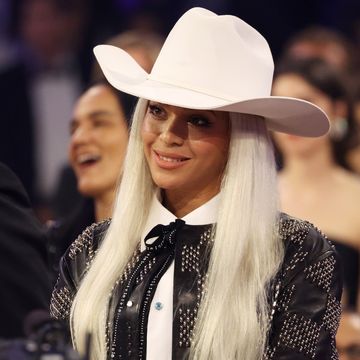
Everything We Know About Beyoncé’s Next Album
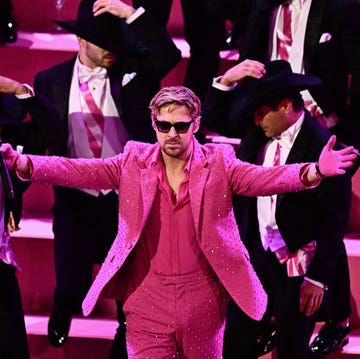
Watch Ryan Perform ‘I’m Just Ken’ at the Oscars
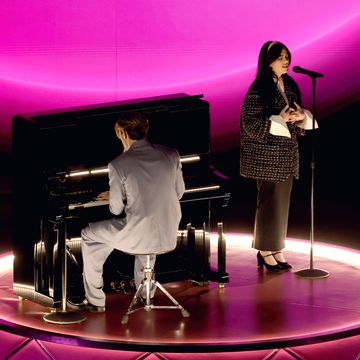
Watch Billie’s ‘What Was I Made For?’ Performance
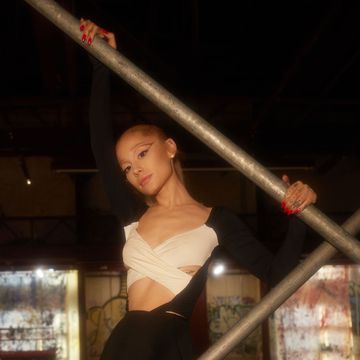
Ariana’s ‘Don’t Wanna Break Up Again’ Lyrics
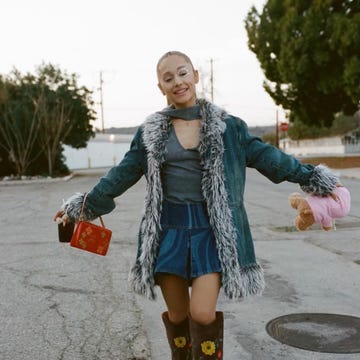
Ariana Listens to Her Nonna on ‘Ordinary Things’

Ariana Grande’s ‘True Story’ Is Actually Untrue

Breaking Down Ariana’s Song ‘We Can't Be Friends’
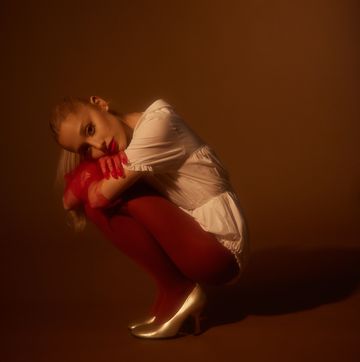
Read Ariana Grande’s ‘The Boy Is Mine’ Lyrics
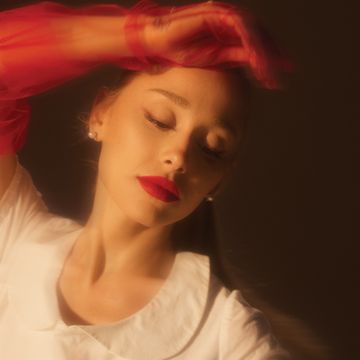
See Ariana Grande’s ‘Eternal Sunshine’ Lyrics
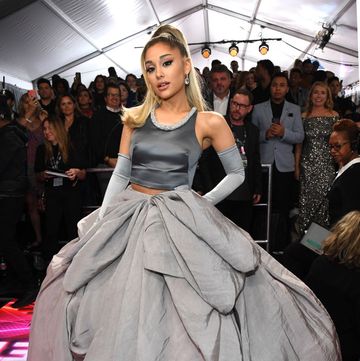
Breaking Down Ariana Grande’s Song ‘Bye’
Latest information about COVID-19
Students will explore Taylor Swift’s lyrics as literature in new course
In new student-initiated course, students will apply literary analysis tools to Taylor Swift’s lyrics to gain new insights into her multilayered music.
Taylor Swift’s prolific output and quality live performances have delivered her to the pinnacle of pop stardom. But if Swift has cultural staying power, it will likely result from her songwriting skills and smart lyrics, where one can find allusions to F. Scott Fitzgerald, William Wordsworth, and Pablo Neruda.
Swift’s songwriting will become the subject of academic debate at Stanford this spring through four new courses. The superstar’s inclusion in the university’s educational offerings comes thanks in part to energetic, Swift-loving sophomore Ava Jeffs. Like many fans, Jeffs describes feeling like she grew up with Swift as the star moved from teen boyfriend songs to more sophisticated narratives tackling larger literary themes.
Jeffs will co-teach TAPS 89SI: The Last Great American Songwriter: Storytelling with Taylor Swift through the Eras , a student-initiated course (SIC) that will dive into Swift’s musical storytelling and literary lyrics.
“When the first Swift class came up at NYU, focusing on her celebrity, it got me intrigued about bringing more modern figures into our curriculum,” Jeffs said. “I was curious about what it would look like to develop a class around her and her music.”

When Jeffs approached Gabriella Safran , senior associate dean for the humanities and arts in the School of Humanities and Sciences, to ask how she might engage her peers in analyzing Swift’s songs, Safran suggested that Jeffs propose a SIC. Marina Johnson, a graduate student in the Department of Theater and Performance Studies, has since worked with Jeffs to turn the idea into a syllabus. Safran, the Eva Chernov Lokey Professor of Jewish Studies and professor of Slavic Languages and Literatures, and Johnson will serve as the instructors of record for the course.
“The tools we have to analyze verbal art are useful, and Ava can help her students learn to apply them,” Safran said. “The university can help Ava get some tools around structuring a class, time management, and class management.”
“It’s time to teach some lessons”
Like Swift’s Eras tour, the topics explored in the course progress album by album. The syllabus pairs a specific interpretive focus with each album to encourage students to apply their textual analysis skills to Swift’s lyrics. For example, one week students will consider symbolism and foreshadowing on the album 1989 . In another week, they will consider Swift’s use of fictional characters to drive narratives in her album Evermore . The course will also lay out the common pop song structures to show how formal manipulation can create meaning.
“As I got more into reading the words, I started to get intrigued about how you could apply your literary analysis to that medium of storytelling,” Jeffs said.
For instance, the class might explore how the chorus of Swift’s murder ballad “No Body, No Crime” plays with pop formulas. Following a common formula, each chorus repeats the same lyrical hooks: “I think he did it, but I just can’t prove it” and “no body, no crime.” But in each iteration, these lines take on new meanings as the song’s plot progresses through successive verses.
Student-initiated courses
Introduced in 2013, SICs enable undergraduates to develop and lead courses with support and mentoring from Stanford faculty and graduate students. In this case, Jeffs, Johnson, and Safran shaped the TAPS 89SI syllabus. Jeffs will lead course discussions with guidance from Johnson, who will be on hand at all class meetings.

SICs are considered activity courses, like most physical education, wellness, and outdoor courses as well as the thematic classes students in programs such as ITALIC take. Students can obtain less than five percent of the credits they need to graduate through these courses, which are one or two credits each and only offered pass/fail.
The benefit to student course leaders is straightforward.
“Students tend to spend most of their time being students and being on the receiving end of education,” Safran said. “For a student to get the experience of thinking about how to design and deliver a class offers incredibly important, useful life skills.”
Johnson champions peer-to-peer learning as a boon for enrolling students. She became Jeffs’ mentor for The Last Great American Songwriter after she served a similar role last spring for a one-unit, student-led ITALIC course on Taylor Swift’s video for “All Too Well (10 Minute Version).”
“One of the things I love about teaching is that it doesn’t have to happen in a very prescriptive way, as long as there’s a pedagogically sound approach,” Johnson said. “There’s an engagement on a different level when you’re learning from a peer about something about which they’re very passionate and know a lot.”
There are guardrails in place to support students co-teaching SICs. Student course leaders must complete online pedagogical training and work closely with an instructor of record, who oversees the curriculum and submits grades.
Welcoming the new
One of the benefits of SICs is they can help bring new cultural forms and ideas in for academic analysis.
“Our students are interested in the present,” Safran said. “We are also interested in the present. Across the university, people are studying the present in different ways.”
To investigate the literary meanings or merit of Swift’s lyrics, critics have to rely on tried-and-true methods of literary scholarship, such as looking for themes, modifications to widely used forms, and allusions to other writers.
“If you’re a humanities researcher, you’re trained mostly to join a conversation that’s already going on, about familiar issues and materials,” Safran said. “If you want to write about something new, something that just happened, you have to stretch. Older material can help anchor you as you analyze the contemporary material and teach your students to analyze it.”
This course is not the only new course to discuss Taylor Swift. Other Stanford courses will also apply proven methods of analysis to Swift’s new forms of expression. They include A Brief History of Now: Song and Poetry from Sappho to Taylor Swift , taught by Marisa Galvez, professor of French and Italian, and Harry Carter, graduate student in comparative literature; and Taylor Swift and Millennial America , taught by Theresa Iker , postdoctoral fellow in history.
“Taylor Swift is very literate in the sense that she’s citing all these canonical writers,” Safran said. “That's part of her appeal. In the new TAPS course, the students can excavate some of these references and figure out what Swift is doing with them.”
Media contact: Joy Leighton, Stanford School of Humanities and Sciences: joy [dot] leighton [at] stanford [dot] edu (joy[dot]leighton[at]stanford[dot]edu)
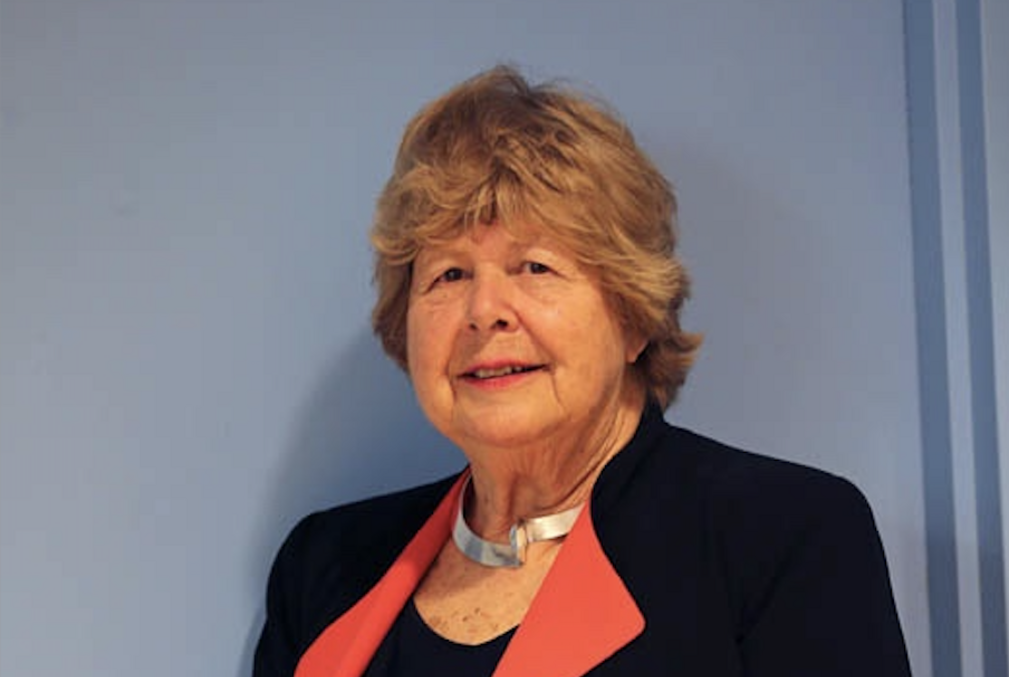
Poetry scholar and critic Marjorie Perloff has died

Kenneth Fields, longtime English professor and acclaimed poet, dies at 84

Steven Boxer receives 2024 Ellis R. Lippincott Award
- Natural Sciences

Yakov Eliashberg receives 2024 Frontiers of Knowledge Award
© Stanford University, Stanford, California 94305
By providing your information, you agree to our Terms of Use and our Privacy Policy . We use vendors that may also process your information to help provide our services. This site is protected by reCAPTCHA Enterprise and the Google Privacy Policy and Terms of Service apply.
The 25 Best Taylor Swift Lyrics of All Time, Ranked, From Every Era
Monica mercuri.
- Share on Facebook
- Share to Flipboard
- Show more sharing options
- Post to Tumblr
- Submit to Reddit
- Share on LinkedIn
- Share on WhatsApp
- Print This Page
Taylor Swift is one of the most influential lyricists of our era. (It’s no surprise that she’s distantly related to 19th-century poet Emily Dickinson.) Swift once said that “a good song transports you to your truest feelings and translates those feelings for you.” Keep reading for the best Taylor Swift lyrics of all time, ranked .
At the 2022 Nashville Songwriter Awards, the singer-songwriter accepted the Songwriter-Artist of the Decade award and opened up about her songwriting process for the first time. “Twenty years ago I wrote my first song. I used to dream about one day getting to bounce around the different musical worlds of my various sonic influences, and change up the production of my albums,” Swift said in her speech. “I hoped that one day, the blending of genres wouldn’t be such a big deal. There’s so much discussion about genre and it always usually leads back to a conversation about melody and production. But that leaves out possibly my favorite part of songwriting: lyricism.”
The musician added that she hasn’t talked about this publicly before because “it’s dorky” and revealed that she had “secretly” established three genres for the lyrics she pens: Quill Lyrics, Fountain Pen Lyrics, and Glitter Gel Pen Lyrics. “I came up with these categories based on what writing tool I imagined having in my hand when I scribbled it down—figuratively. I don’t actually have a quill anymore. I broke it once when I was mad,” she admitted.

Swift continued, “I categorize certain songs of mine in the ‘Quill’ style if the words and phrasings are antiquated, if I was inspired to write it after reading Charlotte Brontë or after watching a movie where everyone is wearing poet shirts and corsets. If my lyrics sound like a letter written by Emily Dickinson’s great grandmother while sewing a lace curtain, that’s me writing in the Quill genre. I will give you an example from one of my songs I’d categorize as Quill.”
As for the Fountain Pen style, Swift said that most of her lyrics fall into this category. “Fountain pen style means a modern storyline or references, with a poetic twist. Taking a common phrase and flipping its meaning. Trying to paint a vivid picture of a situation, down to the chipped paint on the door frame and the incense dust on the vinyl shelf,” she explained. “Placing yourself and whoever is listening right there in the room where it all happened. The love, the loss, everything. The songs I categorize in this style sound like confessions scribbled and sealed in an envelope, but too brutally honest to ever send.”
She categorized the third category, “Glitter Gel Pen,” as “frivolous, carefree, bouncy, syncopated perfectly to the beat.” She continued, “Glitter Gel Pen lyrics don’t care if you don’t take them seriously because they don’t take themselves seriously. Glitter Gel Pen lyrics are the drunk girl at the party who tells you that you look like an Angel in the bathroom. It’s what we need every once in a while in these fraught times in which we live.”
The Best Taylor Swift Lyrics of All Time Ranked

Whether you’re getting over a heartbreak or just want to get in the feels, read on for the best Taylor Swift lyrics from each of the singer’s eras, from her debut album to Midnights .
"You put up walls and paint them all a shade of gray / And I stood there loving you and wished them all away."
Song: “Cold As You”
Album: Debut
As the fifth song on debut, this heartbreaking lyric from “Cold As You” captures the feeling of unconditionally loving someone who is emotionally unavailable. “I wrote this song with Liz, and I think the lyrics to this song are some of the best we’ve ever written,” Swift previously said.
"You paint me a blue sky and go back and turn it to rain / And I lived in your chess game / But you changed the rules every day.”
Song: “Dear John (Taylor’s Version)”
Album: Speak Now (Taylor’s Version)
Swift called “Dear John” her most “scathing” single from Speak Now , but the John Mayor-inspired track articulates the pain and disillusionment felt by an 18-year-old Swift. She has repeatedly used the game theme in other singles, including 1989’s “Blank Space.”
"With your hands in your pockets / And your don’t you wish you had me grin / But I did, so I smiled, and I melted like a child / Now every breath of air I breathe reminds me of then.”
Song: “You All Over Me” (feat. Maren Morris) (Taylor’s Version) (From The Vault)
Album: Fearless (Taylor’s Version)
The vault track “You All Over Me” is one of our favorites from Fearless (Taylor’s Version). This lyric captures the complicated relationship with her ex, Joe Jonas, and the nostalgic feeling of still loving someone and being reminded of them with a simple “breath of air.”
"Cause she's the kind of book that you can't put down / Like if Cleopatra grew up in a small town."
Song: “When Emma Falls in Love (Taylor’s Version) [From The Vault]”
“Emma Falls in Love” is rumored to be about Taylor Swift’s bestie, Emma Stone. Drawing a comparison between the actress, a captivating book, and the Greek goddess Cleopatra showcases Swift’s ability to weave metaphors and vivid imagery into her gorgeous songwriting style.
"And I love you for giving me your eyes / Staying back and watching me shine."
Song: “The Best Day (Taylor’s Version)”
“The Best Day” is a love letter penned by Swift for her mother, Andrea Swift. The lyrics beautifully convey Swift’s admiration for her mother and the encouragement she received from her to chase her dreams. “It was the sweetest thing ever because I just think she couldn’t have comprehended that I would write a song about the two of us,” Swift said to the crowd before playing the track at The Eras Tour last year.
"Time is taking its sweet time erasing you / And you've got your demons / And darlin' they all look like me."
Song: “Sad Beautiful Tragic (Taylor’s Version)”
Album: Red (Taylor’s Version)
“Sad Beautiful Tragic” is one of Swift’s most underrated songs on Red. In this melancholy ballad, Taylor writes about reminiscing about a magical but brief relationship and the aching process of getting over them.
"Barefoot in the kitchen / Sacred new beginnings / That became my religion, listen."
Song: “Cornelia Street”
Album: Lover
Most of the tracks on Lover are dedicated to Swift’s ex-beau Joe Alwyn. She paints a picture of their “sacred” love story with descriptive lyrics to represent her comfort with him, so much so that it became her “religion.”
"I picked the petals / He loves me not / Something different bloomed / Writing in my room ."
Song: “You’re on Your Own, Kid”
Album: Midnights
A homage to her early career, Taylor offers fans a glimpse of the moment she discovered her craft amid teenage heartbreak. She often uses floral references in her lyrics to symbolize different emotions.
"Darling I'm a nightmare dressed like a daydream."
Song: “Blank Space”
Album: Reputation
Who could forget when Swift poked fun at the media’s perception of her in the iconic music video for “Blank Space.” This line from the song sticks out as one of our favorites thanks to the clever use of the idiom “nightmare dressed like a daydream.”
"It was months and months of back and forth / You're still all over me like a wine-stained dress I can't wear anymore.”
Song: “Clean (Taylor’s Version)”
Album: 1989 (Taylor’s Version)
The vivid metaphor of a wine-stained dress in Taylor Swift’s 1989 track “Clean” illustrates the struggle of moving on from an ex-lover and how their lingering presence can feel burdensome in the months after a heartbreak.
“No one wanted to play with me as a little kid / So I’ve been scheming like a criminal ever since / To make them love me and make it seem effortless ."
Song: “Question…?”
Swift often sings about her childhood and the loneliness she experienced as a kid. In this instance, she draws upon past feelings of rejection to explain the insecurities that drive her desire for love and acceptance.
"August slipped away into a moment in time / Cause it was never mine."
Song: “August”
Album: Folklore
In “August,” Swift describes a fleeting moment that was never meant to last forever. The song emulates nostalgia and the feeling of summer slipping away at your fingertips with nothing to do to stop it.
"How can a person know everythin' at 18 / But nothin' at 22?"
Song: “Nothing New (Taylor’s Version) [From The Vault]”
Here, Taylor compares the confidence she felt when she was 18 to the uncertainties of being 22. This lyric perfectly conveys how it feels to get older and long for the uncomplicated days of the past.
"Time mystical time / Cutting me open then healing me fine."
Song: “Invisible String”
In “Invisible String,” Taylor writes about how fate can tie two people together. This lyric reminds us that the magic of time can heal all wounds, even the ones that have caused the most pain.
‘Why’d you whisper in the dark / Just to leave me in the night / Now your silence has me screaming."
Song: “Say Don’t Go (Taylor’s Version) [From The Vault]”
This lyric from Swift’s vault track “Say Don’t Go” is simple yet powerful. She seamlessly integrates the juxtaposition between a whisper and silence with the screams of the night.
"She would've made such a lovely bride / What a shame she's f*cked in the head."
Song: “Champagne Problems”
Album: Evermore
As the final lyric in the “Champagne Problems” bridge, this line culminates all the emotional hurt. She responds to the societal pressures and scrutiny from the media and those who keep asking about her marital status.
"'Cause we were like the mall before the internet / It was the one place to be / The mischief, the gift-wrapped suburban dreams / Sorry for not winning you an arcade ring."
Song: “Coney Island”
“Coney Island” is filled with unforgettable moments, including this nostalgic lyric that describes a love akin to a “suburban dream.” She parallels their romance to the age before the internet when you could simply go to the mall and have a fun time (as well as get into some shenanigans).
"Please don't ever become a stranger / Whose laugh I could recognize anywhere."
Song: “New Year’s Day”
This Taylor Swift lyric from “New Year’s Day” pulls our heartstrings. It describes the thought of losing someone you love and the fear of being reminded of them without getting to be with them.
"The burgundy on my T-shirt when you splashed your wine into me / And how the blood rushed into my cheeks, so scarlet, it was."
Song: “Maroon”
Taylor loves using colors in her lyricism, and she penned the vivid imagery of spilled wine and flushed cheeks to evoke the color of Maroon.
“I’ve never heard silence quite this loud.”
Song: “The Story of Us (Taylor’s Version”
In one of the most iconic and poignant lyrics from “The Story of Us,” Swift simply tells us that silence can be louder than words and is often the most heartbreaking.
"And if you never saved me from boredom / I could have gone on as I was / But, lord, you made me feel important / And then you tried to erase us."
Song: “Would’ve, Could’ve, Should’ve”
In “Would’ve Could’ve Should’ve,” Swift speaks to how someone could enter your life unexpectedly and become your whole world, only for them to break your heart and erase everything you built together. Ouch.
“And you wanna scream / Don't call me kid, don't call me baby / Look at this godforsaken mess that you made me.”
Song: “Illicit Affairs”
You can feel Swift’s emotional pain as she delivers the first lines of the bridge of “Illicit Affairs.” If you attended the Eras Tour, then you know how surreal this moment is when she absolutely goes off.
"And there we are again when nobody had to know / You kept me like a secret but I kept you like an oath."
Song: “All Too Well (10 Minute Version) (Taylor’s Version)”
The crown jewel of Red (Taylor’s Version) , there are so many heartbreaking lyrics from “All Too Well (10-Minute Version)” that it’s hard to choose. The genius juxtaposition between a secret and an oath depicts how her level of commitment was much stronger than his.
"So you were never a saint / And I've loved in shades of wrong / We learn to live with the pain / Mosaic broken hearts."
Song: “State of Grace (Taylor’s Version)”
Taylor is candid about her poor choices in relationships (“I’ve loved in shades of wrong”) and employs the vivid metaphor of a mosaic to represent how the shattered pieces of their broken hearts once formed something beautiful.
"Should've kept every grocery store receipt / 'Cause every scrap of you would be taken from me."
Song: “marjorie”
Taylor writes about grieving her grandmother in Evermore’s “marjorie,” and this particular lyric hits really hard for those who have experienced loss. Wishing you kept everyday items like grocery receipts represents the desperate desire to hold onto your loved ones.
Most Popular
You may also like.
![taylor swift lyric analysis essay ‘American Idol 22’ episode 7 recap: Who are the Top 24? [Live Blog]](https://www.goldderby.com/wp-content/uploads/2024/04/American-Idol-showstoppers.jpg?resize=232,175)
10 Taylor Swift Lyrics We’ll Never Forget
Prepare to be “Enchanted,” from ‘Fearless’ to ‘Midnights.’

Taylor Swift is renowned not only for her captivating melodies and infectious hooks but also for her masterful lyricism. With a knack for storytelling and a keen understanding of human emotions, Taylor has penned some of the most memorable and thought-provoking lyrics in contemporary pop music . From love and heartbreak to empowerment and self-discovery, her songs explore a myriad of themes, earning her the title of one of the best lyricists in the industry.
One of Taylor Swift’s greatest strengths as a lyricist lies in her ability to capture the complexities of relationships with honesty and vulnerability. Whether she’s detailing the euphoria of new love or the anguish of a breakup, Taylor’s lyrics are raw and relatable, yet still deep.
Songs like “All Too Well” and “Clean” showcase her talent for weaving intricate narratives that resonate with listeners on a deeply personal level, evoking feelings of nostalgia, longing, and resilience, while anthems like “Shake It Off” and “The Man” encourage listeners to embrace their individuality, defy societal expectations, and stand tall. Each lyric is meticulously crafted to evoke a specific mood or emotion, resulting in songs that linger in the hearts and minds long after the last note fades.
Taylor’s status as one of the best lyricists in the music industry is well-deserved. We’ve rounded up some of what we consider to be her most beloved lyrics — from her self-titled debut album back in 2006, all the way up to her musical masterpiece, Midnights , and every re-recording in between.
Prepare to be “Enchanted.”
Are you ready for it?

Don’t have SiriusXM yet? Start listening today!
1. “cold as you” – taylor swift (2006), “and you come away with a great little story of a mess of a dreamer with the nerve to adore you”.
From the earliest days of her career, Taylor has used her lyrics to convey the deepest of heartache and betrayal. These lines about the hopefulness of youth transport us straight back to our teenage years.
2. “Fifteen” – Fearless (2008)
“’cause when you’re fifteen and somebody tells you they love you you’re gonna believe them”.
From the lyrics about her first day at school to her first kiss, this song still hits us like a sucker punch. Taylor’s power lies in the way she can recall her younger years with pitch-perfect clarity.
3. “Dear John” – Speak Now (2010)
“but i took your matches before fire could catch me, so don’t look now i’m shining like fireworks over your sad empty town”.
These bittersweet lyrics remind us to never dull our shine for anyone. “Dear John” became an instant classic over a decade ago, and we have a feeling that its re-release on the hotly-anticipated Speak Now (Taylor’s Version) will be life-changing.
4. “All Too Well” – Red (2012)
“and you call me up again just to break me like a promise so casually cruel in the name of being honest”.
Of course, we also mean the 10-minute version. These lyrics have become a cultural institution, and the short film has racked up almost 80 million views in the year since its release!
5. “Blank Space” – 1989 (2014)
“got a long list of ex-lovers they’ll tell you i’m insane”.
Taylor’s first full pop album is, unsurprisingly, full of absolute bops. “Blank Space” addresses rumors about her love life with a tongue-in-cheek nonchalance that powers through into her next album. This line also sparked a misheard-lyric phenomenon, which even had Taylor’s mom singing, “All the lonely Starbucks lovers.”
6. “Look What You Made Me Do” – Reputation (2017)
“honey, i rose up from the dead i do it all the time”.
There’s only so much heartbreak one girl can take. With these lyrics, Taylor rises from the ashes, revealing a bigger and badder persona. She plots some good old-fashioned revenge in what many believe to be a reference to her longstanding beef with a certain rapper.
7. “Lover” – Lover (2019)
“have i known you twenty seconds or twenty years”.
These lyrics capture the magic of feeling like you’ve known someone forever — even if you’ve only just met. It’s beautiful when you feel truly comfortable with someone you love, and we’ll listen to Taylor sing about it all day long.
8. “exile” (feat. Bon Iver) – folklore (2020)
“second, third, and hundredth chances balancing on breaking branches”.
In a piano ballad for the ages, Taylor and Bon Iver come together to offer a heart-wrenching tale of the kind of heartbreak that takes far too long to sink in.
Check out Bastille’s beautiful cover of the song here:
9. “no body, no crime” (feat. HAIM) – evermore (2020)
“that ain’t my merlot on his mouth that ain’t my jewelry on our joint account”.
Harking back to her country roots, Taylor takes a page out of The Chicks’ book in this murder-revenge story. Joined by HAIM, her sisters in crime, Taylor lays out the signs of infidelity before the story takes an even darker turn.
10. “Bejeweled” – Midnights (2022)
“puttin’ someone first only works when you’re in their top five and by the way, i’m going out tonight”.
No number of fire emojis could ever possibly convey just how hard these lyrics go in the latest Taylor Swift era of dreamy, atmospheric pop.
Here’s what Ryan Reynolds had to say about his family’s love for the album, “swear words included”:
Get Presale Tickets to Mariah Carey’s Exclusive Las Vegas Engagement
Music, sports, news and more.
All in one place on the SiriusXM app
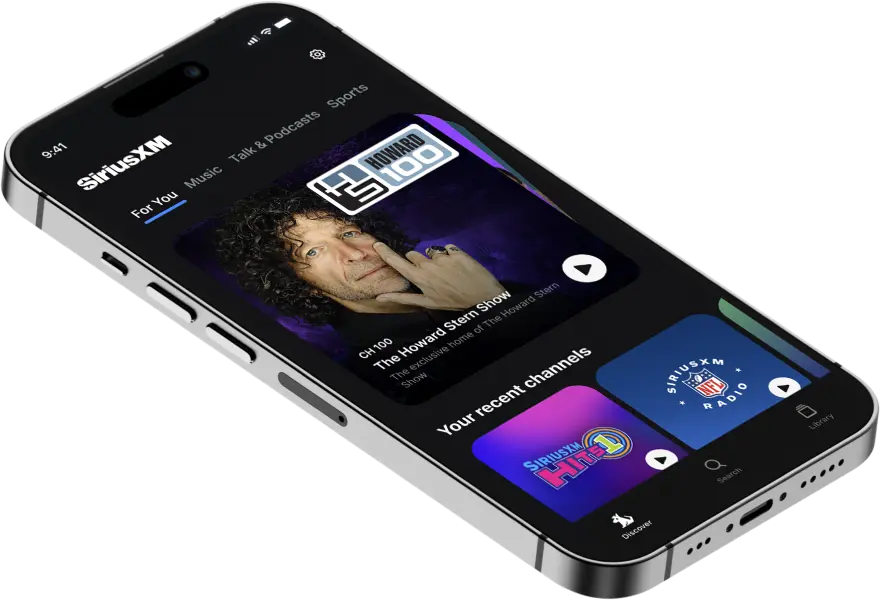
Shop NewBeauty Reader’s Choice Awards winners — from $13
- TODAY Plaza
- Share this —

- Watch Full Episodes
- Read With Jenna
- Inspirational
- Relationships
- TODAY Table
- Newsletters
- Start TODAY
- Shop TODAY Awards
- Citi Music Series
- Listen All Day
Follow today
More Brands
- On The Show
50 Taylor Swift trivia questions for serious Swifties only
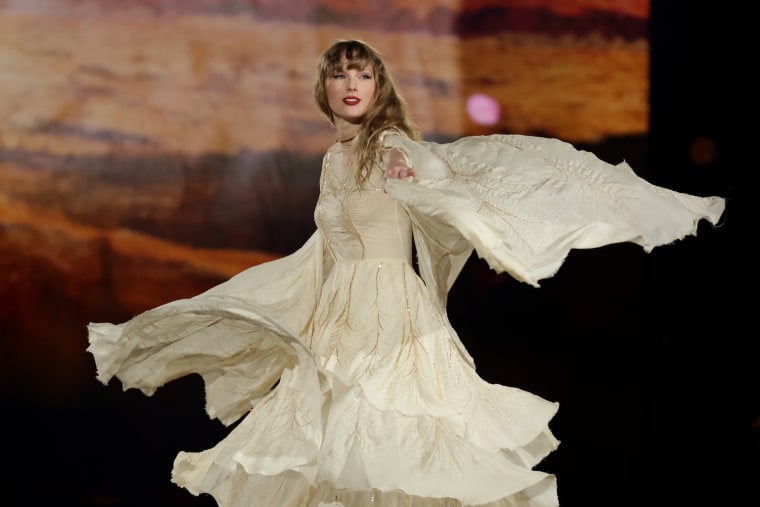
Ladies and gentlemen, it’s time to put your Taylor Swift knowledge to the test.
Regardless of during which era ushered you into your Swiftie obsession, it’s safe to say Taylor Swift fans feel very connected to the pop icon. Whether it’s ticking off favorite award show outfits, reciting the setlist of your first concert or singing songs lyric-by-lyric among crowds of 70,000 proud concertgoers, it's clear that Swifties take their fandom very seriously.
Now, with the recent announcement of her new album, “The Tortured Poets Department,” fans are excited as ever to see what the singer and songwriter has up her sleeve. But before you blast your vinyl, pair up with a fellow Swift aficionado and see how you do on these trivia questions.
Be fearless and see how many you get right. (And if you can’t come up with the correct answers to ‘em all, don’t sweat it — a recent “Jeopardy” contestant flubbed a Taylor Swift question and the world goes on, folks.)
Ahead, 50 questions about Taylor Swift for whoever is red-y to have some fun.
Taylor Swift Trivia Questions

- What is Taylor Swift’s middle name? Answer: Alison.
- Where was Taylor Swift born? Answer: West Reading, Pennsylvania.
- What is Taylor Swift’s birthday? Answer: December 13, 1989.
- What is Taylor Swift’s brother’s first name? Answer: Austin.
- What is Taylor Swift’s mother’s first name? Answer: Andrea.
- What is Taylor Swift’s father’s first name? Answer: Scott.
- In what year was Taylor Swift given TIME magazine’s Person of the Year award? Answer: 2023.
- Is Taylor Swift’s brother older or younger than she is? Answer: Younger.
- What is the name of Taylor Swift’s maternal grandmother? Answer: Marjorie Moehlenkamp Finlay.
- What female pop star is the song “Bad Blood” said to be about? Answer: Katy Perry.
- What is Taylor Swift’s signature lipstick color? Answer: Red.
- On what kind of farm did Taylor Swift grow up? Answer: Christmas tree farm
- In what town in Pennsylvania did Taylor Swift grow up? Answer: Wyomissing.
- What was Taylor Swift’s maternal grandmother’s vocation? Answer: Opera singer.
- What country star was Taylor Swift scheduled to open for on a 2007 summer tour? Answer: Kenny Chesney.
- Who is the apparent namesake of the song “Dear John?” Answer: John Mayer.
- In what Nashville concert venue was Taylor Swift famously discovered? Answer: The Bluebird Cafe.
- Taylor Swift is named after which famous singer-songwriter? Answer: James Taylor.
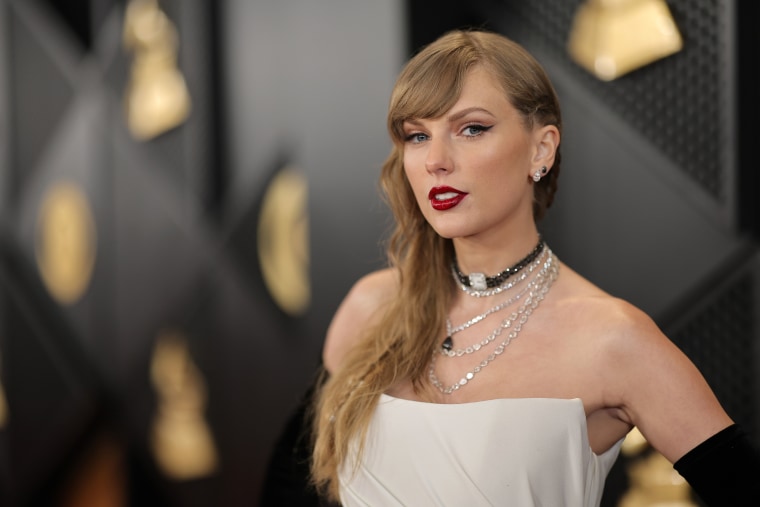
- On what date did the 2023 Eras Tour kick off? Answer: March 17, 2023.
- What is Taylor Swift’s lucky number? Answer: 13.
- What is the name of Taylor Swift’s 2020 Netflix documentary? Answer: “Miss Americana.”
- What is the name of Taylor Swift’s management company? Answer: 13 Management.
- What is the name of Taylor Swift’s first studio album? Answer: “Taylor Swift.”
- How many GRAMMY Awards has Taylor Swift won? Answer: 14.
- What was the name of Taylor Swift’s first fragrance? Answer: Wonderstruck.
- What are the titles of Taylor Swift’s pair of 2020 pandemic albums? Answer: “Folklore” and “Evermore.”
- In what 2010 romantic comedy did Taylor Swift have a supporting role? Answer: “Valentine’s Day.”
- In what New York City neighborhood does Taylor Swift reside? Answer: Tribeca.
- What crime drama series did Taylor Swift appear as a guest in 2009? Answer: “CSI: Crime Scene Investigation.”
- What character did Taylor Swift play in the movie adaptation of the Broadway musical “Cats?” Answer: Bombalurina.
- What kind of jewelry have fans been known to wear to the Eras Tour? Answer: friendship bracelets.
- On what streaming platform can you watch the concert film “Taylor Swift: The Eras Tour (Taylor’s Version)?” Answer: Disney+.
- What are the names of Taylor Swift’s three pet cats? Answer: Meredith Grey, Olivia Benson and Benjamin Button.
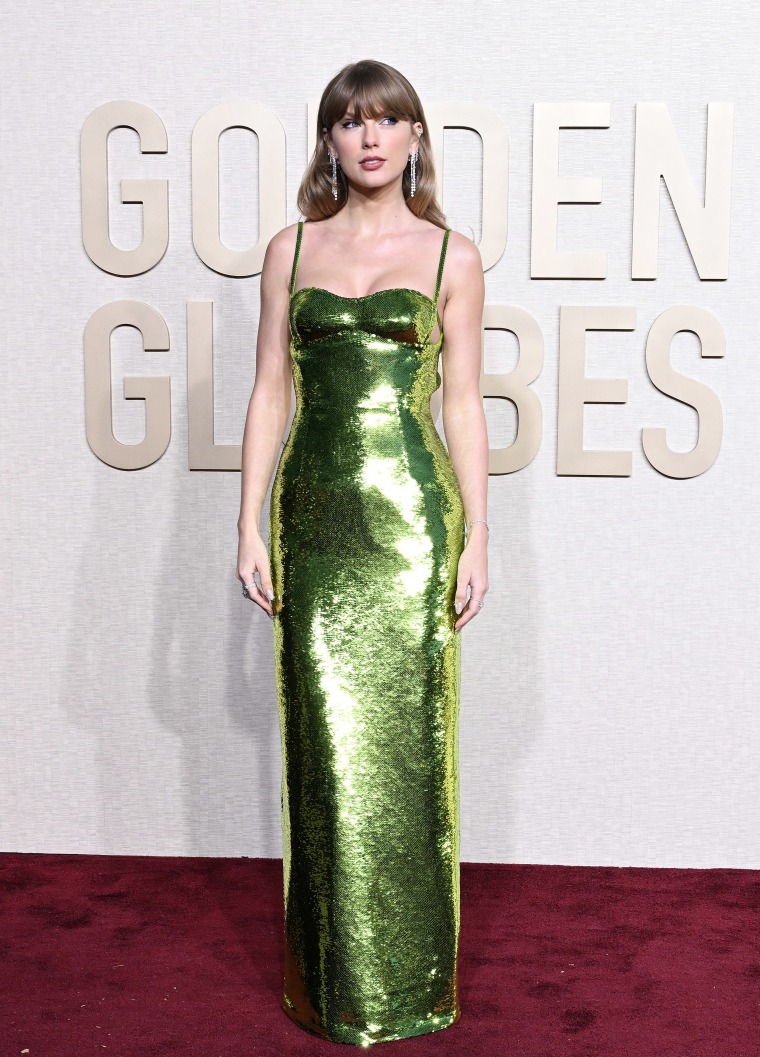
- Taylor Swift had a partnership with what soda brand? Answer: Diet Coke.
- Taylor Swift has appeared in several commercials for what bank? Answer: Capital One.
- What two Taylor Swift Songs were on Spotify’s top global songs of 2023 list for the most streams worldwide? Answer: “Cruel Summer” and “Anti-Hero.”
- What suburb of Nashville, Tennessee, did Taylor move to as a teenager with her family to pursue her music career? Answer: Hendersonville
- In what city and state did the 2023 Eras Tour start? Answer: Glendale, Arizona.
- What band performs on the Taylor Swift song “Coney Island” in the 2020 album “Evermore?” Answer: The National.
- What album did Taylor Swift call her first “official pop album?” Answer: “1989.”
- What musician infamously interrupted Taylor Swift’s 2009 acceptance of an MTV Video Music Award for Best Female Video? Answer: Kanye West.
- In what 2012 animated film did Taylor Swift play a voice role? Answer: “Dr Seuss’ The Lorax.”
- In what Rhode Island neighborhood does Taylor Swift have a vacation home? Answer: Watch Hill.
- What is the album release date of “Tortured Poets Department?” Answer: April 19, 2024.
- What Dave Matthews Band song did Taylor Swift cover in 2011? Answer: “You and Me.”
- What famous novel does Taylor Swift allude to on the 2017 song “This Is Why We Can’t Have Nice Things?” Answer: “The Great Gatsby”
- For which record label did Taylor Swift sign a recording contract in 2005? Answer: Big Machine Records.
- What is Taylor Swift’s Zodiac sign? Answer: Sagittarius
- What was the name of Taylor Swift’s debut concert tour? Answer: The Fearless Tour.
- What album was the first album Taylor Swift wrote on her own? Answer: “Speak Now.”
So, you still want more Taylor Swift?
- 'Shake' It Off: Here are Taylor Swift's biggest seismic songs
- Here’s the 101 on the literary connections to Taylor Swift’s ‘Tortured Poets Department’ track list
- Alicia Keys looks back on viral video of her son waving at Taylor Swift: ‘He was flirting’
Perri is a New York City-born-and-based writer. She holds a B.A. in psychology from Columbia University and is also a culinary school graduate of the Natural Gourmet Institute. She's probably seen Dave Matthews Band in your hometown, and she'll never turn down a bloody mary. Follow her on Twitter @66PerriStreet or learn more at VeganWhenSober.com

IMAGES
COMMENTS
The fourteenth track on Taylor Swift's tenth studio album Midnights, "The Great War" is a heartbreaking ballad regarding an argument sparked between two lovers rooted in trauma from past ...
18. "You tell me about your past thinking your future was me" - All Too Well(Red) If this doesn't scream poetic, I don't know what does. 19. "I can see you starin', honey / Like he's just your understudy" - exile (folklore) A very theatricalway of describing your ex seeing you in a new relationship. 20.
A specialised corpus, the Taylor Swift Corpus (TSC), was compiled with a total of 189 song lyrics from 10 Taylor Swift albums, from her debut album - Taylor Swift (2004) to the latest release ...
Taylor Swift is a monument to the idea that there once was a place called America. She recalls an old American dream—of high school popularity contests, apple pies, dreamy boys next door, and a very old, very white, Christian nation. She is classic, insofar as her lyrics are about 'me and the boy', rarely tag the present moment, and ...
This Is Me Trying Explained. "This Is Me Trying" is a poignant and introspective track from Taylor Swift's critically acclaimed album "Folklore," released in 2020. The song delves into the complexities of self-reflection, personal growth, and the feelings of vulnerability that come with acknowledging one's own mistakes and shortcomings.
An analytical-but-personal essay inspired by Taylor Swift's song "The Man" and navigating a seemingly male-dominated music industry. I n 2019, one of the most successful female artists of the century, Taylor Swift, released her seventh studio album Lover. However, it was only Swift's first record she owned the full rights to.
A specialised corpus, the Taylor Swift Corpus (TSC), was compiled with a total of 189 song lyrics from 10 Taylor Swift albums, from her debut album - Taylor Swift (2004) to the latest release ...
Hey everybody, Thanks for once again attending my seminar on the Genius.com interpretation of the lyrics to Taylor Swift's popular track, Cardigan, off the hit 2020 album Folklore. When we last visited this subject, we discussed the first half of the initial verse of the song (three lines total) and the exhaustive and thoughtful annotations provided by Genius.com.
To begin an analysis of the work of Taylor Swift, this article traces her stylistic development through a series of song case studies drawn from successive albums, her collaborations with co-writers and producers, and the 2016 hit by Calvin Harris and Rihanna that was co-written by Swift under a pseudonym, 'This is What You Came For'. ...
In a YouTube chat, Swift revealed that "no body, no crime" was inspired by her love of true crime podcasts. The song follows a woman named Este (named for Este Haim) whose husband cheats on ...
Taylor Swift's "Clean" - lyrics analysis. Taylor Swift's "Clean" from the album "1989" is a symbolic representation of the aftermath of a relationship and the journey to self-discovery and healing. Drawing on vivid metaphors and imagery, Swift narrates a story of heartbreak and eventual catharsis that echoes familiar cultural and literary ...
Cardigan Explained. "Cardigan" is a captivating song by Taylor Swift from her eighth studio album, "Folklore," which was released on July 24, 2020. The track showcases Swift's songwriting depth and evolution, as she delves into the complexities of love, heartbreak, and personal growth. With introspective lyrics, haunting melodies, and ...
taylor swift's folklore: stepping into the lyrics. I wrote an essay (started before evermore ever existed) that I have finished in time for the one year anniversary of folklore!It's 9k words long and explores the different themes and imagery that appear in folklore.. There are different interpretations of the songs as the essay goes on, relating to different themes such as The Teenage Love ...
Swift is expressing her feminism in progressively more public ways, with "The Man" as one of the most upfront ways she has done so. Swift is not afraid to hide it and she's not afraid to put ...
Let's Discuss the Lyrics to Every Song on Taylor Swift's Lover 12 minute read Taylor Swift performs onstage during the 2019 Billboard Music Awards at MGM Grand Garden Arena on May 1, 2019 in ...
Activity #1: Analyzing Taylor Swift Poem Lyrics Together. ... I created the TSWIFT Method adapted from the SWIFT poem analysis method. I even created Taylor Swift themed graphic organizers to go with the lessons. ... Teaching how to write a literary analysis essay can be tough. If you want to simplify the writing process for your students while ...
Midnights. : An Analysis by Four Editors and Taylor Swift Fans. "It's like 1989, Reputation, and Folklore had a child all together.". A new Taylor Swift album isn't just something to ...
An analysis of Taylor Swift's music vide, The Man first year writing seminar 09 final draft april 2021 miss americana: the malleability of gender in the ... singalong pop song with pointed contrast between its melody and meaningful lyrics" (Thompson). For fans of Martin Scorsese and Leonardo DiCaprio, the opening scenes of Swift's video ...
In new student-initiated course, students will apply literary analysis tools to Taylor Swift's lyrics to gain new insights into her multilayered music. April 1, 2024 Taylor Swift's prolific output and quality live performances have delivered her to the pinnacle of pop stardom. But if Swift has cultural staying power, it will likely result ...
In her 2016 speech accepting the Grammy Award for Album of the Year for 1989, Taylor Swift gave a message directed at any young women who were watching: 'focus on the work'. Taking Swift's emphasis on 'the work' as a guide, this article surveys Swift's changing compositional techniques and her reception as a songwriter over the course of her career. Though one of the most-discussed ...
A bstract. This research paper aims to analyze and identify the lyrics written in Taylor Swift's eighth studio album, folklore, as a modern-day depiction and homage to the romantic-style literature era. In this context, the Romantic literature era is defined as it is originally in its glory days; which is the literary movement that began in ...
Thus, I present: "this is me trying: lyrical parallels to our lives.". To begin the song, Taylor claims that "I've been having a hard time adjusting, I had the shiniest wheels now they're rusting.". This attitude of great promise yet greater disappointment resonates with me as we step into a new year. Many of us had great hopes for ...
Song: "Say Don't Go (Taylor's Version) [From The Vault]". Album: 1989 (Taylor's Version) This lyric from Swift's vault track "Say Don't Go" is simple yet powerful. She seamlessly ...
These lyrics capture the magic of feeling like you've known someone forever — even if you've only just met. It's beautiful when you feel truly comfortable with someone you love, and we'll listen to Taylor sing about it all day long. 8. "exile" (feat. Bon Iver) - folklore (2020)
Answer: Younger. What is the name of Taylor Swift's maternal grandmother? Answer: Marjorie Moehlenkamp Finlay. What female pop star is the song "Bad Blood" said to be about? Answer: Katy ...